#Brandenburger nobility
Photo




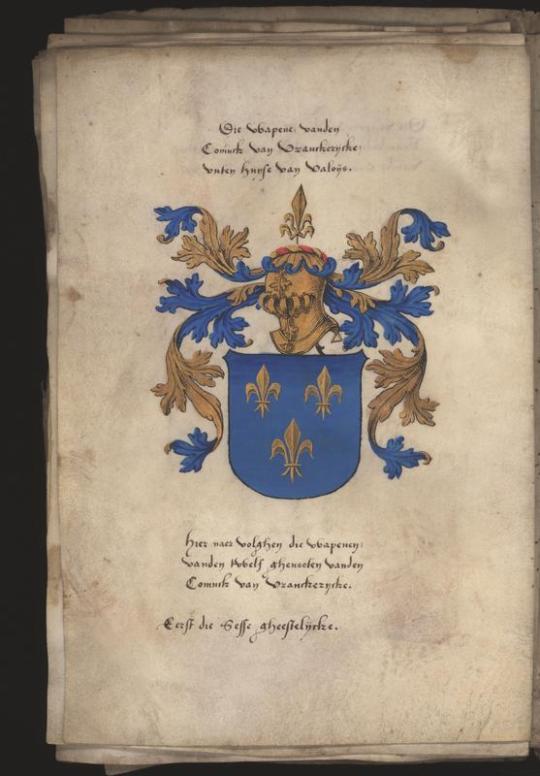
"The twelve virtues of nobility", followed by an armorial. Folio (320 x 215 mm), [24]-[2 bl.] ff. on parchment, in pen and black ink, coats of arms with watercolor. Binding: waste from a liturgical manuscript in Latin. Text: calligraphic French verse, celebrating the virtues of the nobleman: nobility, faith, beauty, honor, righteousness, prowess, love, courtesy, diligence, neatness, generosity and sobriety. The armorial is made up of 30 coats of arms with their stamps, captioned in Dutch. The first 10, in large format, relate to large sovereign houses (Holy Empire, Bohemia, Brandenburg, Valois, Saxony, etc.), the other 20, in smaller format, relate in particular to the former Netherlands (Duchy of Brabant, counties of Flanders, Holland, Zeeland, Hainaut, Namur...) and the royal houses of Valois, Aragon, Bohemia and Portugal.
(via "Les douze vertus de la noblesse", with an armo...)
#heraldry#nobility#medieval manuscripts#manuscripts#illumination#coats of arms#french#poetry#muspeccoll#mizzou#university of missouri#libraries#private collection#fb#kelli h
98 notes
·
View notes
Text
one unfortunate problem if largely doing away with the concept of aristocracy is that people don’t fucking know how titles work anymore. The idea that William III of Prussia was both a King or Margrave depending on the context would melt their brains. Clergymen holding land in right of their office? Inconceivable. The British Monarch ruling the channel islands as the Duke of Normandy because they aren’t legally part of the Unites Kingdom of GB and NI? Madness.
These days, people don’t even know that Christ isn’t the guy’s name. It’s a mocking title bestowed upon him by the Romans, who REALLY did not understand his whole deal.
You’ve heard of a Shougun? Well check this out: Shougun is an old military title that was given to a nobleman commissioned to do colonialism against the indigenous people of Northern Japan. Knowing that as well as what the office would eventually come to entail tells you something about the history of title and how its holders leveraged it to gain power over the centuries.
The final boss of understanding titles is learning about Personal Unions. How could William III be King and Margrave? Well, he was both King in Prussia (ask me about that in sometime) and Margrave of Brandenburg, but these offices were not one office. Prussia and Brandenburg had distinct laws, customs, and governing organs. Thus, he was both King and Margrave. Btw, this is how the United Kingdom became united. A Scot inherited the English throne and then a century on, his descendant rationalized the government of both countries by unifying their parliaments. However, this never formally dissolved Scotland, just its parliament, which is why it still has its own laws, nobility, and a few other concessions to self rule. Theoretically, Scotland leaving Britain wouldn’t necessarily undo the Acts of Union if the independent country became a republic. This would mean that Charles would remain King of Scotland, he just would lose de facto jurisdiction over the land that Kingdom rules. And yeah, every republic in Europe still sits upon land that a bunch of still living aristocrats continue to lay claim to. The last German Emperor didn’t die without an heir, so there’s still a Prince of Prussia and the French royal throne has a bunch of claimants from a number of branches of the Bourbon dynasty. The French imperial throne also has at least one, maybe two, Bonaparte claimants. I turns out that kingdom (or duchy, archbishopric, county, and so on), is not a place or a set of laws and customs or even the people who inhabit the former and are ruled by the latter. No, a kingdom (or duchy, archbishopric, county, and so on) is a mental construct defined by a title and a person who holds it (or could theoretically hold it).
#claire thoughts#anyway scaramouche wasnt a fucking archon#a god sure#but lots of people have been gods#to be an archon is to be selected by celestia#neuvillette didnt become an archon when he took the gnosis and neither did signora#and venti zhongli ei and nahida remain archons in the absence of their gnoses#this was secretly a genshin post#and not so secretly a special interest post
7 notes
·
View notes
Note
Do you have any theories as to the cause(s) of Mary and Anne's obstetrical problems?
In fact I do, but II would like to preface my reply with several huge caveats:
This is all mere speculation based on historical information.
I'm not a doctor, so I have no authority to speak on medical issues of any kind.
Even a doctor could not form a concrete diagnosis based on what little historical circumstantial evidence there is; they would have to examine the person in question for that, which is naturally not really possible if we're talking about someone who died in 1694.
With that out of the way, here's what I think: It may not have been the same medical issue for both sisters. While Mary struggled to conceive, Anne's children often were stillbirths or died very shortly after birth. I know a lot more about Mary, though, than Anne.
Mary was married extremely young; she was 15, and just a few months shy of her 16th birthday when she was sure that she was pregnant. Now, the body of a person this young is absolutely not meant to be pregnant, and I wonder if that may have been a factor triggering the first miscarriage, with the rough carriage ride to Breda, where she wanted to meet her husband while the latter was on campaign, also factoring in.
As far as was reported, the miscarriage proved pretty hazardous for Mary's health, keeping her abed for weeks. To me, it seems likely that she may have sustained internal injuries that may have prevented her from ever successfully carrying a child to term.
There is an interesting detail that causes me to suspect that Mary and her physicians had a similar suspicion: In the late 1680s, Justine Siegmund was a guest at the court of the Hague.
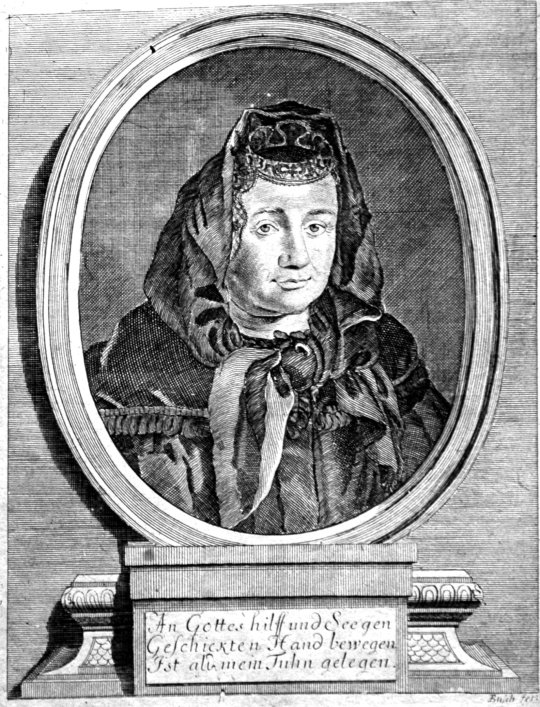
Justine Siegmund, ca. 1690.
Justine Siegmund was the officially appointed midwife to the electoral court of Brandenburg, and had delivered a great many children of the German royalty and nobility, while still attending other births in the Berlin area.
Siegmund had initially started to become interested in gynecology and obstetrics after she had suffered a uterine prolapse at the age of 20. The midwives her husband had consulted had been unhelpful and diagnosed a false pregnancy (a diagnosis that was uttered in connection to Mary's last pregnancy, too), causing Siegmund to feel not taken seriously, and suffering a lot of pain as a result of not receiving adequate medical care.
Following her own traumatic experience, Siegmund trained to become a midwife herself in order to improve conditions for other women.
She rose to become the city midwife of Legnica in 1670, and in time was appointed to the court of Brandenburg by Friedrich Wilhelm "The Great Elector" in 1683.
Said elector had been married to Louise Henriette of Orange for his first marriage, who had been William's aunt. The elector had also played a role in William's guardianship during his minority, and of the Brandenburg children, William had reportedly been pparticularly close with the oldest, Karl Emil, who died in his late teens. Friedrich, the next eldest brother, would become the first King in Prussia and became elector in 1688, the same year his father died and Justine Siegmund may have arrived at the Dutch court.
Given her prominent position as court midwife, it looks as if Friedrich sent Wiliam and Mary Justine Siegmund for a consultation. Their struggle to conceive was discussed openly enough among their family; Sophie von Hannover, for instance, also weighed in on it in letters.
For Justine Siegmund, the trip to The Hague must have been a professional success; not only did it prove that the electoral court held her in high esteem, the Netherlands, and especially the medical faculty at Leiden, were the ideal place for a medical professional to meet new people and exchange ideas. Among her contacts, and contributing anatomical engravings for the handbook for midwives Siegmund was writing, was Govard Bidloo, who in 1695 would be appointed to the unenviable post of personal physician to William III.
What made her so special among other midwives of her age was not just her position at court: while it was customary for midwives to be women who had born a child of their own, Siegmund never had any children.
She also, and this is where things get quite interesting, performed medical interventions that went beyond monitoring pregnancies and assisting during birth. Indeed, what first caught the eye of male medical doctors of the time was not a particularly difficult birth she helped to bring to a successful conclusion, it was the removal of the Duchess of Legnica's cervical tumor.
So while her official title was that of a midwife, Siegmund's expertise was also in the field of gynecological surgery.
To me, it would make perfect sense that Siegmund was sent from Brandenburg to the Netherlands in order to examine Mary, and, if possible, perform an operation on her to 'fix' whatever prevented her from having children.
In time, Siegmund returned to Brandenburg. What she may have discussed with Mary and William remains mere conjecture, but I would consider it likely that she informed them of the impossibility of another pregnancy due to the injuries Mary had sustained a decade earlier.
So, all things considered, I think that Mary was a victim of marriage politics; although it is mere conjecture, it seems likely that, had she been married later, and thus had started to try for a baby at a somewhat more advanced age (say, in her early 20s), the chances for a successful pregnancy, birth and subsequently healthy mother and infant would have been drastically increased.
As for Anne, I reach the limitations of my deducting based on historical circumstantial evidence. I simply have not come across enough sources pertaining to Anne's reproductive health yet, and don't have the medical background knowledge to speculate with reasonable certanty on possible conditions.
Perhaps her lifestyle (which was an inescapable cycle of never ending pregnancies, being therefore prescribed to rest and good food being one of the few things she could indulge in at the time) may have contributed to her struggling with giving birth to a healthy child; to this day, doctors will (and are in some places even mandated to) warn expectant mothers who fall into a medical definition of being overweight that their weight might impact the development of their child adversely.
This is very likely not the sole reason and more of an additional, contributing factor, but it is the only speculation on the subject of Anne that I can comfortably express without veering into the realm of half-baked, and uninformed conjecturing.
Perhaps someone with a much more sound combination of medical and historical knowledge would like to add some commentary or criticism on this?
#tw pregnancy#tw pregnancy loss#tw miscarriage#history#british history#mary ii#william of orange#william iii#justine siegmund#17th century#ask#ask reply#redladydeath#tw child death#tw childbirth#obstetrics#obstetrics and gynecology
14 notes
·
View notes
Text
11 notes
·
View notes
Photo
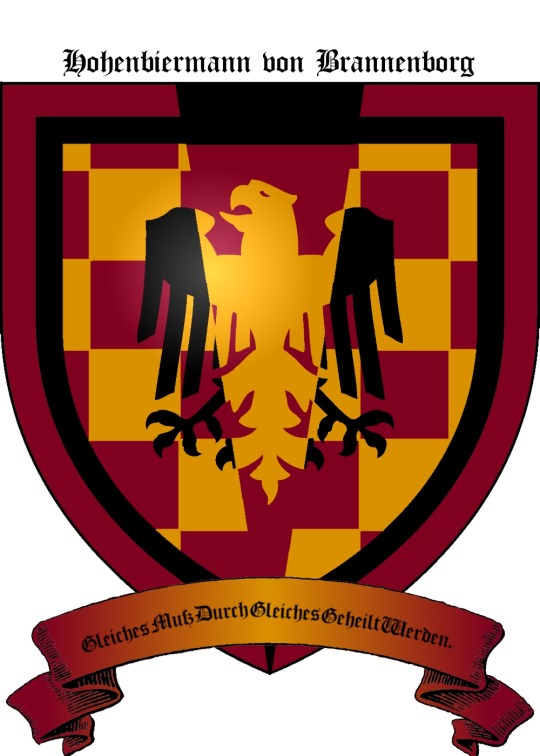

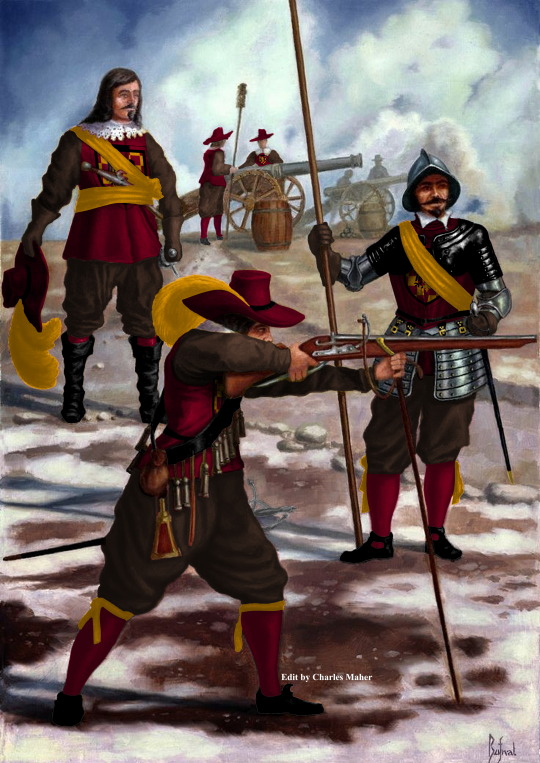


Some illustrations of pike-and-shotte infantry and gunpowder-based, siege artillery that I have officially designed for “Hohenbiermann Der Markgrafschaft Brannenborg” or “House Biermann of The Margraviate of Brannenborg,” the newest of the four secular, hereditary “Kurfürsten Des Selbst Kaiserreich der Menscheit” or “Prince-Electors of The Empire of Mankind Proper.” Both these artworks and their associated “faction iconography” were officially designed for a low-fantasy setting of my original conception with technology and material culture roughly equivalent to European History during the compounded advents of The Italian Renaissance, The Protestant Reformation, and The Discovery of America. Where formations of heavily armoured and mounted, aristocratic and noble knights in either suits of full plate armour or heavy coats of chainmail fight alongside professional armies of pikemen and matchlock musketeers. Where medieval-style stone castles are gradually being outsourced in favour of both lavish country estates and devoted military fortifications, or “bastions,” due to the technological advancements being made in gunpowder-based, siege artillery. And Where fledgling nation-states in the form of both kingdoms and empires look beyond the great oceans and the frontiers of “The Known World” in search of exotic riches and virgin lands.
In context to the canon lore of my “homebrew” medieval fantasy world, “Hohenbiermann Der Markgrafschaft Brannenborg” or “House Biermann of The Margraviate of Brannenborg” is the newest of the four secular, hereditary “Prince-Electors” or “Kurfürsten” within The Imperial College of “Das Selbst Kaiserreich der Menscheit” or “The Empire of Mankind Secundus.” “Die Markgrafschaft Brannenborg” or “The Margraviate of Brannenborg” is loosely inspired by “The Mark Brandenburg” or “The Electorate of Brandenburg” within “The Holy Roman Empire” during the Medieval and the Early Modern periods of European history. “Hohenbiermann Der Markgrafschaft Brannenborg” is at once the newest, and the most reluctant, constituent member state of, and territorial addition to The Empire of Mankind Proper, or “Das Selbst Kaiserreich der Menscheit.” As well as the newest secular, hereditary “electoral principality” or “Kurfürstentum” within The Empire of Mankind since the official appointment of Markgraf Friedrich II Von Biermann to The Imperial College during The Electoral Reforms of Emperor Vespasian VII as the 96th Emperor-Elect of The Empire of Mankind Secundus. Over 150 years prior to the contemporary events of my medieval fantasy setting, the lands of “Hohenbiermann Der Markgrafschaft Brannenborg” was originally part of “The Former Kingdom of The Midlands” under “The Late House Bartholemew” before the untimely extinction of the legitimate, male bloodline of their dynastic household and the subsequent collapse of their hereditary state. As the territorial part of The Former Kingdom of The Midlands most heavily afflicted by the wholesale peasant uprisings agitated by the religious indoctrination and the systematic, mass conversion of the local populace by the hut shamans hailing from “Erdøk,” or “The Great Forest” directly east of The Empire of Mankind Proper. The illegitimate son and the heir apparent to the last King of The Midlands born to House Bartholemew originally pawned, and then permanently transferred the future lands of “Die Markgrafschaft Brannenborg” to “The Imperial Household,” the direct descendants of Prinz Heinrich von Nymphenburg as The First Crowned Imperator of The Empire of Mankind Secundus, as well as the hereditary, dynastic, “great house” of “Imperial Princeps” or “Imperial Magnates” for “Der Reichstaat” or “The Imperial Demesne,” in order to fund his equally desperate and futile war effort against the recalcitrant great houses of feudal aristocracy and nobility in The Former Kingdom of The Midlands. Who had universally rejected his lawful and legitimate succession to The Former Kingdom of The Midlands due to his birth as an illegitimate issue to the last King of The Midlands from The Late House Bartholemew.
Due to it’s polar, geographic distance and territorial dislocation from “Der Reichstaat” or “The Imperial Demesne” as the hereditary, dynastic lands of “The Imperial Household” or “Der Kaiserliche Haushalt,” as well as it’s constant affliction by the wholesale peasant uprisings agitated by both the religious indoctrination and the systematic, mass conversion efforts of the local populace by the hut shamans indigenous to “Erdøk” or “The Great Forest.” Friedrich Biermann, one of the most seasoned, battle-hardened generals within “The Imperial Army” mostly levied, and later conscripted from the hereditary, dynastic lands of “The Imperial Household” seated at “Nymphenburg.” As well as one of the few commoners within the recorded history of The Imperial Army to be promoted to an office of military command by sheer virtue of merit, was officially awarded hereditary, dynastic enfeoffment over “The Southern Imperial March” or “Die Sudetenmark” for his years of meritorious service as a domestic, household general in service to The Imperial Army. As the local populace of The Southern Imperial March or “Die Sudetenmark” were longtime apostates from The Conservative Church of The New Gods who would never acknowledge the newly enfeoffed and anointed “Friedrich Von Biermann” as their liege lord and princeps. Friedrich Von Biermann as “Der Markgraf Der Sudetenmark” officially petitioned to Archpatriarch Cassadorian XIV seated at The Holy Sept of Romulus to prosecute an “errantry war” or a “great crusade” against the religious apostates of Die Sudetenmark, who were largely religiously subscribed to the druidic, cult worship of “Erdøk” or “The Great Forest.” Manfred Von Lichtenstein, Bishop-Prince of Garyalburg, one of the three ecclesiastical, invested, “prince-electors” or “Kurfürsten” of The Empire of Mankind Proper and Archpatrichal Legate to Cassadorian XIV for this new “Albic Crusade,” officially preached and prosecuted “The Albic Crusade” at a holy synod of Bishop-Princes and Grand Abbots at Die Universität Wörtzburch in Das Herzogtum Solingen, one of the leading centres of church-sanctioned, academic research on both The Canon Theology of The New Gods, as well as Cosmopolitan, Classical Romulan Civil Law and Jurisprudence north of The Olympian Mountain Valley. In addition to the retinues of crusading, aristocratic and noble knights and the peasant levies hailing from the multitude, or the plethora of minor “Austere” or “Northern Imperial” states as well as the constituent states of “The Borderlands Confederacy” directly south of “Der Reichstaat” or “Nymphenburg.” This “Albic Crusade” was generally only heeded by a minority of the baronial magnates from Das Herzogtum Solingen as the native, electoral principality of Markgraf Friedrich Von Biermann’s birth and origin before his formal enlistment into The Imperial Army based in “Der Reichstaat” or “Nymphenburg,” as well as their domestic, household retinues of aristocratic, noble knights and their feudal levies of men-at-arms. Knowing that the odds were still highly unfavourable towards Friedrich Von Biermann as the titular “Markgraf Der Sudetenmark” leading at the forefront of The Albic Crusade, despite it’s formal and official preaching and prosecution by Manfred Von Lichtenstein at The Holy Synod of Die Universität Wörtzburch as Bishop-Prince of Garyalburg and Archpatriarchal Legate to Cassadorian XIV. Maximillian IV as the 94th Emperor-Elect of The Empire of Mankind Secundus and the hereditary, dynastic, “Imperial Princeps” or “Imperial Magnate” for “Der Reichstaat” or “The Imperial Demesne” offered to permanently transfer to Friedrich Von Biermann fulltime command over a mighty host of professional, Imperial Army men-at-arms regiments and knightly retinues in return for acceding to an official “Imperial Act of Incorporation.” Where Friedrich Von Biermann and all his hereditary, dynastic successors as “Die Margrafen Der Sudetenmark” would both acknowledge the feudal, hereditary, “Imperial Princeps” or “Imperial Magnate” of “Der Reichstaat” or “The Imperial Demesne” and the dynastic patriarch of The Imperial Household as their liege lords and suzerains for “Die Sudetenmark,” unconditional to their formal election as the preferential candidates for the title of Emperor-Elect of Mankind. As well as subsequently incorporating Hohenbiermann’s hereditary lands of Die Sudetenmark as the newest, and perhaps most reluctant, constituent member state of, and territorial addition to The Empire of Mankind Proper.
Bolstered with permanent, fulltime command over a mighty host of professional, Imperial Army men-at-arms regiments and knightly retinues hailing from “Der Reichstaat” or “The Imperial Demesne” in joint partnership with Bishop-Prince Manfred Von Lichtenstein as “Archpatriarchal Legate,” or the pontifical representative to the person of Cassadorian XIV as “The 269th Bishop of Romulus” and “The Head of The Conservative Church of The New Gods” for this “Albic Crusade” formally preached and prosecuted against the apostate, Albic tribes religiously subscribed to the druidic, cult worship of “Erdøk.” The Albic Crusade had concluded in overwhelming triumph for both Markgraf Friedrich Von Biermann and the crusaders with the final conquest of the greatest Erdøki cultist stronghold of “Brenna.” With the stunning and the official conclusion of The Albic Crusade at The Siege of Brenna, The castletown of Brenna as the final and greatest site of Erdøki cultist resistance was formally consecrated by Bishop-Prince Manfred von Lichtenstein as The Archbishopric of Brannenborg-An-Der-Havel. Where Manfred Von Lichtenstein was formally invested, with Archpatriarch Cassadorian XIV’s explicit blessing, the awesome and prestigious ecclesiastical office of Bishop-Patriarch of Brannenborg in order to facilitate the systematic, mass conversion of the apostate, Albic tribes autochthonous to Die Sudetenmark back into the fold of The Conservative Church of The New Gods officially seated in The Holy Sept of Romulus as the civilizational kernel, historic capital, and titular namesake of both The Cosmopolitan, Classical Romulan Republic and “The Empire of Mankind Primus.” Friedrich Von Biermann as the first and only “Markgraf der Sudetenmark” would thus subsequently rule from the newly consecrated Archbishopric of Brannenborg-An-Der-Havel, or the former Erdøki castletown of “Brenna,” as his official seat of power. formally restyling himself as “Der erster und herrshend Markgraf von Brannenborg und Der Gründungschef von Hohenbiermann.”
With the next two and a half decades spent as “Der erster und herrschend Markgraf von Brannenborg und Der Gründungschef von Hohenbiermann,” Friedrich I Von Biermann would award hereditary, dynastic enfeoffment to the most arable lands, titles, and estates that had not been previously claimed as the official property of The Conservative Church of The New Gods first and foremost to the conquering, crusading knights directly involved in The Albic Crusade, and secondly to the regimental colonels of the former Imperial Army men-at-arms regiments who had distinguished themselves with meritorious service, valour, and skill at arms. This new class of landed, hereditary, feudal aristocracy and nobility, or “junkers,” would come to “characterize,” or otherwise “engender” the entirety of the reign of Markgraf Friedrich I Von Biermann with a significant degree of military fortification in the form of stone castles and city walls in order to protect both themselves and their loyal subjects against the outrage and the predations of the apostate, Albic tribes, who had both stubbornly resisted, as well as deeply resented their forced, mass conversion back into the fold of The Conservative Church of The New Gods. These “great houses” of “junker” princeps and magnates, paying feudal homage to “Hohenbiermann Der Markgrafschaft Brannenborg,” would collectively facilitate the gradual and effective resettlement of skilled, moneyed, and educated settlers and immigrants hailing from the “Austere” or “Northern Imperial” cultural and linguistic hemisphere of The Empire of Mankind Secundus. Most notably into the newly established castles and fortified cities established directly by Friedrich I Von Biermann as Der erster und herrschend Markgraf von Brannenborg und Der Gründungschef von Hohenbiermann, as well as any castles and fortified cities constructed under the princely, “great houses” of “junker” aristocracy and nobility paying feudal homage to Hohenbiermann Der Markgrafschaft Brannenborg. The culturally and ethnically “Austere” or “Northern Imperial” settlers and immigrants settling within these newly established castles and fortified cities, as well as the most lucrative and arable rural estates of attached countryside, would form base of commercial, industrial, cultural, and scholastic life in the new “Markgrafschaft Brannenborg” in the form of the urban “burghers” or bourgeoisie, merchants, artisans, and professionals, as well as the rural “kollmers” or country gentlemen. The gradual and effective resettlement of culturally and ethnically “Austere” or “Northern Imperial” settlers and immigrants into the newly established castles and fortified cities of Die Markgrafschaft Brannenborg and the rural estates of their attached countryside, as well as the systematic, mass conversion efforts with the subsequent and complimentary cultural assimilation of the autochthonous, apostate, Albic tribes by the culturally and ethnically “Austere” or “Northern Imperial” Conservative clergy, with their traditional monopoly over knowledge, learning, and education in general, would characterize “The Sudsiedlung” in Die Markgrafschaft Brannenborg as the last, and undoubtably the most reluctant, constituent member state and territorial addition to be officially incorporated into The Empire of Mankind Secundus. “Die Markgrafschaft Brannenborg” alongside neighboring “Königreich Middenland” based uniquely beyond the southernmost frontiers of The Empire of Mankind Proper well over a century after the stunning and final conclusion of The Albic Crusade at The Siege of Brenna, would collectively form “Die Sudkreuzritterstaaten,” “Die Teutogenstaaten,” or “Die Sudentscheidenstaaten.” A “Teutogen” or “Southern Austere” cultural and linguistic bloc born of the complimentary events of “The Southern Crusades,” or the religious warfare and the territorial conquests of the lands of the apostate, Albic tribes religiously subscribed to druidic, cult worship of “Erdøk” or “The Great Bastion” across the easternmost frontiers of “Das Selbst Kaiserreich Der Menscheit” or “The Empire of Mankind Proper,” and “The Sudsiedlung,” or the gradual and effective resettlement of settlers and immigrants from the “Austere” or the “Northern Imperial” cultural and linguistic hemisphere of The Empire of Mankind Secundus with the synonymous, complimentary, and systematic, mass conversion and the thorough cultural assimilation of the apostate, Albic tribes religiously subscribed to the druidic, cult worship of “Erdøk.”
As implied by both it’s historic and it’s present strategic value as the last, and undoubtably the most reluctant, constituent member state of and territorial addition to The Empire of Mankind Secundus through Emperor Maximillian IV’s “Imperial Act of Incorporation” officially brokered with Markgraf Friedrich I Von Biermann in return for his military contributions in both manpower and resources against the apostate, Albic tribes indigenous to “Die Sudetenmark” during The Albic Crusade. “Hohenbiermann Der Markgrafschaft Brannenborg,” since the historic reforming of “Die Sudetenmark” around the church-sanctioned consecration of The Basilica of Brannenborg-An-Der-Havel over the site of the former Erdøki castletown of Brenna, has been deprecated by both nobles and plebeians alike throughout the entirety of The Empire of Mankind as “The Imperial Sandbox.” Such an epithet implying the generally meagre, base economic and industrial yield and value that has come to characterize Die Markgrafschaft Brannenborg ever since Markgraf Friedrich I Von Biermann had finally asserted his de jure rule over the region with The Albic Crusade and the subsequent and complimentary “Sudsiedlung.” Long before the final collapse of The Former Kingdom of The Midlands beginning with the untimely extinction of the legitimate, male bloodline of The Late House Bartholemew. The lands of the future “Markgrafschaft Brannenborg” were already characterized by an overabundance of swamps, marshes, and thick, wild, impenetrable forests. What little economy, industry, material culture, and infrastructure that had previously existed within the region had largely been ecologically “reclaimed” by the Albic tribes religiously subscribed to the druidic, cult worship of “Erdøk” or “The Great Forest.” With Friedrich I Von Biermann’s de jure assumption of power and authority over the region, any apostate, Albic tribes who had both violently and openly resisted their systematic, mass conversion back into the fold of The Conservative Church of The New Gods by the culturally and ethnically “Austere” or “Northern Imperial” clergy had faced systematic, mass genocide at the hands of both the fledgling, yet highly competent professional army of Hohenbiermann Der Markgrafschaft Brannenborg, as well as the feudal, aristocratic levies of knightly retinues and men-at-arms regiments paying military service and direct homage to the princely, “great houses” of “junker” aristocracy and nobility. This equally stubborn and violent resistance put up by the Albic natives religiously subscribed to the druidic, cult worship of Erdøk would subsequently and consequently result in a significant depopulation of their number in the region by either the professional, armed forces paying direct homage and military service to Hohenbiermann Der Markgrafschaft Brannenborg, themselves, or the feudal, aristocratic levies of knightly, heavy cavalry and men-at-arms regiments paying direct homage and military service to the princely, “great houses” of “junker” aristocrats and nobles paying feudal homage to Hohenbiermann Der Markgrafschaft Brannenborg as their liege lords and Imperial Princeps. Friedrich II Von Biermann as the second Markgraf von Brannenborg born to Hohenbiermann had only and finally achieved official appointment for Hohenbiermann Der Markgrafschaft Brannenborg into The Imperial College as the newest of the four secular, hereditary “Kurfürsten Des Selbst Kaiserreich der Menscheit” or “Prince-Electors of The Empire of Mankind Proper” as a reward for acceding to the obligatory call to arms by his unconditional feudal overlord and suzerain Vespasian VII against the official partisans of his political and military opposition for his lawful and legitimate election as the 96th Emperor-Elect of Mankind.
Under the hereditary, dynastic rule of Albrecht Von Biermann as “Der herrshend Markgraf von Bannenborg,” “Der momentan Chef von Hohenbiermann,” and secular, hereditary “Kurfürst des Selbst Kaiserreich der Menscheit” has the fortunes of Hohenbiermann Der Markgrafschaft Brannenborg changed exponentially for the better. With the advent of the theological reforms to the religious establishment of, and the institutions of organized religion within The Conservative Church of The New Gods officially seated within The Holy Sept of Romulus as the civilizational kernel, historic capital, and titular namesake of both The Cosmopolitan, Classical Romulan Republic and “The Empire of Mankind Primus” formally preached and published by Karl Von Luxembourg at Die Universität Wörtzburch as one of the leading centers of church-sanctioned, academic research on The Canon Theology of The New Gods and Cosmopolitan, Classical Romulan Civil Law and Jurisprudence north of The Olympian Mountain Valley, as well as the original site of the church-sanctioned preaching and prosecution of The Albic Crusade by Bishop-Prince Manfred Von Lichtenstein at The Holy Synod of Wörtzburch. Has Albrecht Von Biermann taken the opportunity to confiscate the lands, property, and treasuries of any ecclesiastical and the monastic clergy of The Conservative Church of The New Gods who had both openly resisted and protested against the formal renunciation of his spiritual ties of fealty to The Holy Sept in Romulus in order to enrich both the state coffers of “Hohenbiermann Der Markgrafschaft Brannenborg,” as well as any aristocratic, noble, “great houses” of “junker” princeps and magnates in Die Markgrafschaft Brannenborg personally sympathetic to the theological reforms officially preached and published by Karl Von Luxembourg. Albrecht Von Biermann as “Der herrschend Markgraf von Brannnenborg,” “Der momentan Chef von Hohenbiermann,” and secular, hereditary “Kurfürst des Selbst Kaiserreich der Menscheit” had formally decreed state legislation to officially renounce the old, Classical Romulan rite and liturgy of The Conservative Church of The New Gods originally formalized and decreed under the religious reforms traditionally attributed to The Cosmopolitan, Classical Romulan Imperator of Mankind “Cassadorian the Great” in favour of “The Luxembourgian Reformation” with it’s theological emphasis on both the vernacular translations and the strict, universal interpretation of The Holy Canons of The New Gods by all social classes outside the ecclesiastical and monastic clergy and the feudal aristocracy and nobility. With Albrecht Von Biermann’s legislative decree to officially convert to The “Reformed” Faith of The New Gods based on the theological reforms officially preached and published by Karl Von Luxembourg at Die Universität Wörtzburch on behalf of both his dynastic household and his hereditary subjects, has Albrecht Von Biermann officially become both the second hereditary, dynastic ruler in both the recorded histories and the geographic expanse of “The Known World” after Friedrich I as “Der erster und herrschend König von Middenland und Der Gründungschef von Hohenrotbart” based uniquely beyond the southernmost frontiers of The Empire of Mankind Proper, as well as the first hereditary, dynastic, “Imperial Princeps” or “Imperial Magnate” to formally and officially annul his spiritual ties of fealty to The Holy Sept in Romulus as the historic capital, civilizational kernel, and titular namesake of both The Cosmopolitan, Classical Romulan Republic and “The Empire of Mankind Primus.” With Hohenbiermann Der Markgrafschaft Brannenborg’s spiritual ties of fealty to The Holy Sept in Romulus formally annulled, has Albrecht Von Biermann finally assumed supreme authority over matters of religion in Die Markgrafschaft Brannenborg. And in the process making himself the effective and virtual “Supreme Head of The Reformed Church of The New Gods in Die Markgrafschaft Brannenborg.” As a direct consequence of his formal assumption of supreme authority over matters of religion, as well as the formal renunciation of his spiritual ties of fealty to The Holy Sept in Romulus, has Albrecht Von Biermann effectively endowed himself with full control over the state investiture of new bishops and abbots for “The Reformed Church of The New Gods in Die Markgrafschaft Brannenborg.” Including state investiture over the venerable and prestigious ecclesiastical office of “Bishop-Patriarch of Brannenborg-An-Der-Havel” since it’s original establishment with the church-sanctioned consecration of The Basilica of Brannenborg-An-Der-Havel over last and greatest Erdøki cultist stronghold of “Brenna” by Manfred Von Lichtenstein as it’s Seminal Bishop-Patriarch.
In addition to his formal assumption of supreme authority over matters of religion in Die Markgrafschaft Brannenborg, as well as his systematic confiscation of the lands, property, and treasuries of any ecclesiastical and monastic clergy of The Conservative Church of The New Gods who had openly refused to submit before the formal renunciation of his spiritual ties of fealty to The Holy Sept in Romulus. Albrecht Von Biermann as “Der herrschend Markgraf von Brannenborg,” “Der momentan Chef von Hohenbiermann,” and secular, hereditary “Kurfürst des Selbst Kaiserreich der Menscheit” has actively pursued an extraimperial personal union with “Hohenrotbart Des Königreich Middenland” based uniquely beyond the southernmost frontiers of The Empire of Mankind Secundus. Using their shared background as the earliest religious converts to The “Reformed” Faith of The New Gods based on the theological reforms of Karl Von Luxembourg to the religious establishment of, and institutions of organized religion within The Conservative Church of The New Gods officially seated at The Holy Sept of Romulus as the historic capital, civilizational kernel, and titular namesake of both the Cosmopolitan, Classical Romulan Republic and “The Empire of Mankind Primus.” As well as his paternal, dynastic ties to Friedrich I as “Der erster und herrschend König von Middenland und Der Gründungschef von Hohenrotbart” originally established through the marriage of the younger sister of his late father and predecessor Markgraf Friedrich-Albrecht Von Biermann to “Der erster und herrschend König von Middenland und Der Gründungschef von Hohenrotbart” shortly after the stunning and official conclusion of The Midlands Crusade with the climactic “Battle of The Godswoods” as “the pretext,” or otherwise “the rationale” for a prospective personal union. Has Albrecht Von Biermann actively pursued the agenda of merging Die Markgrafschaft Brannenborg with Das Königreich Middenland into an extraimperial composite state united by their shared heritage as “Die Sudkreuzritterstaaten,” “Die Teutogenstaaten,” or “Die Sudentscheidenstaaten,” or cultures and states born of the subsequent and complimentary events of “The Southern Crusades” and “The Sudsiedlung.” As well as their shared background as the earliest religious converts to The “Reformed” Faith of The New Gods based on the theological treatises of Karl Von Luxembourg questioning both the spiritual and cultural legitimacy and moral infallibility of “The Bishop of Romulus” or “The Archpatriarch” as well as his spiritual, cultural, and moral power and authority as “The Last of The Classical Pontiffs,” or the sole, anointed representative to The Entire Canon Pantheon of The New Gods in the world. Within the subsequent “Treaties of Marienburg and Brannenborg-An-Der-Havel” officially brokered between the state-sanctioned, court representatives of “Hohenbiermann Der Markgrafschaft Brannenborg” and “Hohenrotbart Des Königreich Middenland,” respectively. Has Albrecht Von Biermann as “Der herrschend Markgraf von Brannenborg,” “Der momentan chef von Hohenbiermann,” secular, hereditary “Kurfürst des Selbst Kaiserreich der Menscheit,” and nephew to Friedrich I offered to establish mutual heredity between Hohenbiermann and Hohenrotbart for both Die Markgrafschaft Brannenborg and Das Königreich Middenland, should either dynastic house officially grow extinct through the male bloodline. Friedrich I as “Der erster und herrschend König von Middenland,” “Der Gründungschef von Hohenrotbart,” and paternal uncle to Albrecht Von Biermann, in direct response to his nephew’s introductory proposition, elaborated upon the opening proposition. Only agreeing to the outlined terms under the conditions that Das Königreich Middenland never be incorporated into The Empire of Mankind Proper as both a constituent, member state and a territorial addition. As Imperial law had officially “restricted,” or otherwise “excluded” all constituent, member states outside “Hohenluxembourg Des Königreich Schönbrunn” and “the hereditary state” and “the dynastic house” of the Emperor-Elect, himself from endowing the reigning patriarch of their dynastic household with royal titles. That Albrecht Von Biermann and all of his prospective successors as “Die Markgrafen von Brannenborg” officially convert to The “Reformed” Faith of The New Gods by the time of their formal inheritance to Das Königreich Middenland from the then extinct, male bloodline of Hohenrotbart. So as to simultaneously protect and preserve the religious liberties of all subscribers to The Reformed Church of The New Gods in Das Königreich Middenland, while also encouraging both the spread and the proliferation of The Reformed Church of The New Gods in Die Markgrafschaft Brannenborg. And that Albrecht Von Biermann and all of his prospective successors as “Die Markgrafen von Brannenborg” officially serve as both regents and godfathers to Friedrich I’s infant son Kronprinz Friedrich-Albrecht Von Rotbart in the event and the occasion of his untimely passing. As Friedrich I as Der erster und herrschend König von Middenland und Der Gründungschef von Hohenrotbart had only and finally succeeded in producing a surviving male heir by his late 70′s. Albrecht Von Biermann, in response to his paternal uncle’s diplomatic elaborations, both sweetened and concluded the subsequent and complimentary “Treaties of Marienburg and Brannnenborg-An-Der-Havel.” Outlining within his ultimatum the final condition that Friedrich I and all of his prospective successors as “Die Könige von Middenland” officially hold the title of “Der Markgraf von Brannenborg” plurally with the title of “Der König von Middenland” upon inheriting Die Markgrafschaft Brannenborg from the then extinct, male bloodline of Hohenbiermann. As opposed to incorporating Die Markgrafschaft Brannenborg as a constituent province of Das Königreich Middenland uniquely situated within the southernmost frontiers of “Das Selbst Kaiserreich der Mensceit,” so as to simultaneously preserve and retain the awesome power, authority, and privilege traditionally associated with the title of secular, hereditary “Kurfürst des Selbst Kaiserreich der Menscheit” that had been both traditionally, and synonymously tied with the hereditary, dynastic title of “Der Markgraf von Brannenborg” since The Electoral Reforms of Vespasian VII as the 96th and official Emperor-Elect of Mankind. With this diplomatic agenda of finally merging Das Königreich Middenland and Die Markgrafschaft Brannenborg into an extraimperial composite state based on their shared heritage as “Die Sudkreuzritterstaaten,” “Die Teutogenstaaten,” or “Die Sudentscheidenstaaten” born of the subsequent and the complimentary events of “The Southern Crusades” and “The Sudsiedlung,” as well as their shared background as the earliest religious converts to the theological reforms of Karl Von Luxembourg to the religious establishment of, and institutions of organized religion within The Conservative Church of The New Gods. Albrecht Von Biermann actively pursues the dynastic ambition of acquiring hereditary, dynastic control over lands, armies, and wealth for his dynastic household that is virtually and effectively beyond the power, authority, influence, and jurisdiction of “Der Kaiserliche Haushalt” or “The Imperial Household” officially seated in “Der Reichstaat” or “The Imperial Demesne,” known colloquially as “Nymphenburg.” While also finally breaking away from his ancestral obligations of unconditional feudal homage to The Imperial Household seated at distant Nymphenburg in return for their historic military contributions in both manpower and resources officially granted to “Der erster und herrschend Markgraf Der Sudetenmark und Der Gründungschef von Hohenbiermann” for his church-sanctioned crusade against the apostate, Albic tribes indigenous to Die Sudetenmark that formed from the northernmost part of The Former Kingdom of The Midlands under The Late House Bartholemew.
In terms of both the hereditary, dynastic military traditions of Hohenbiermann in particular, as well as the culturally ingrained, provincial, military traditions of Die Markgrafschaft Brannenborg in general. Die Markgrafschaft Brannenborg under the hereditary, dynastic rule of Die Markgrafen von Hohenbiermann arguably possesses the single, most competent, professional military of any constituent, member state within The Empire of Mankind Secundus. Despite it’s official status as the last, and arguably the most reluctant, constituent member state of, and territorial addition to The Empire of Mankind Proper. Linear descendants of the military traditions of the professional, Imperial Army men-at-arms regiments and knightly retinues permanently transferred to the fulltime military command and the direct supervision of Friedrich I Von Biermann in order to bolster his gradual and eventual pacification of the apostate, Albic tribes indigenous to “Die Sudetenmark” during, and in the wake of “The Albic Crusade.” And steeled by many decades of quasi-perpetual warfare against the apostate, Albic tribes who had both violently resisted and openly protested against their systematic persecution and the legislative marginalization of their religious liberties at the hands of a culturally and ethnically “Austere” or “Northern Imperial” Conservative clergy. Die Markgrafschaft Brannenborg under the hereditary, dynastic rule of Die Markgrafen von Hohenbiermann possesses a highly formidable, professional, disciplined, and skilled-at-arms corps of elite pike-and-shotte infantry regiments. One whose professional quality and numeric quantity are both significantly disproportionate to the meagre, base economic and industrial yield and value of Die Markgrafschaft Brannenborg. With the sudden, recalcitrant uprising of over half of the princely, “great houses” of “junker” aristocrats and nobles who had both openly resisted and violently protested against Albrecht Von Biermann’s legislative decree for his official conversion to The Luxembourgian Reformation on behalf of both his dynastic household and his hereditary subjects, as well as the subsequential and consequential annulment of his spiritual ties of fealty to The Holy Sept in Romulus. Most notably the formidable, provincial power and authority of the junker princeps and magnates of “Hohenlictenstein” as the hereditary, dynastic household of Bishop-Patriarch Manfred Von Lichtenstein as the church-sanctioned, Archpatriarchal Legate to the person of Cassadorian XIV for The Albic Crusade, as well as The Seminal Bishop-Patriarch of Brannenborg-An-Der-Havel. Has Albrecht Von Biermann officially responded to the political, religious, and military opposition for his formal assumption of supreme authority over matters of religion as “The Supreme Head of The Reformed Church of The New Gods in Die Markgrafschaft Brannenborg” by investing a significant portion of his state treasury into the latest technological advancements made in the novel design of gunpowder-based, siege artillery in order to effectively nullify the formal opposition of both the recalcitrant, princely, “great houses” of “junker” aristocracy and nobility, as well as any burgher and kollmer enclaves openly opposed and resistant to The Luxembourgian Reformation, by reducing their respective castles and fortified cities to ash and rubble.
#coats of arms#heraldry#shields#medieval#renaissance#pikemen#pikes#musketeers#matchlock musketeers#muskets#matchlock muskets#halberdiers#halberds#arquebusiers#arquebuses#culverins#artillery#siege artillery#swords#plate armour#cuirasses#fantasy#fantasy world#graphic design#art#Albrecht Von Biermann
7 notes
·
View notes
Text
Events 6.11
173 – Marcomannic Wars: The Roman army in Moravia is encircled by the Quadi, who have broken the peace treaty (171). In a violent thunderstorm emperor Marcus Aurelius defeats and subdues them in the so-called "miracle of the rain".
631 – Emperor Taizong of Tang sends envoys to the Xueyantuo bearing gold and silk in order to seek the release of Chinese prisoners captured during the transition from Sui to Tang.
786 – A Hasanid Alid uprising in Mecca is crushed by the Abbasids at the Battle of Fakhkh.
980 – Vladimir the Great consolidates the Kievan realm from Ukraine to the Baltic Sea. He is proclaimed ruler (knyaz) of all Kievan Rus'.
1011 – Lombard Revolt: Greek citizens of Bari rise up against the Lombard rebels led by Melus and deliver the city to Basil Mesardonites, Byzantine governor (catepan) of the Catepanate of Italy.
1118 – Roger of Salerno, Prince of Antioch, captures Azaz from the Seljuk Turks.
1157 – Albert I of Brandenburg, also called The Bear (Ger: Albrecht der Bär), becomes the founder of the Margraviate of Brandenburg, Germany and the first margrave.
1345 – The megas doux Alexios Apokaukos, chief minister of the Byzantine Empire, is lynched by political prisoners.
1429 – Hundred Years' War: Start of the Battle of Jargeau.
1488 – Battle of Sauchieburn: Fought between rebel Lords and James III of Scotland, resulting in the death of the king.
1509 – Henry VIII of England marries Catherine of Aragon.
1559 – Don Tristan de Luna y Arellano sails for Florida with party of 1,500, intending to settle on gulf coast (Vera Cruz, Mexico).
1594 – Philip II recognizes the rights and privileges of the local nobles and chieftains in the Philippines, which paved way to the stabilization of the rule of the Principalía (an elite ruling class of native nobility in Spanish Philippines).
1748 – Denmark adopts the characteristic Nordic Cross flag later taken up by all other Scandinavian countries.
1770 – British explorer Captain James Cook runs aground on the Great Barrier Reef.
1775 – The American Revolutionary War's first naval engagement, the Battle of Machias, results in the capture of a small British naval vessel.
1776 – The Continental Congress appoints Thomas Jefferson, John Adams, Benjamin Franklin, Roger Sherman, and Robert R. Livingston to the Committee of Five to draft a declaration of independence.
1788 – Russian explorer Gerasim Izmailov reaches Alaska.
1805 – A fire consumes large portions of Detroit in the Michigan Territory.
1825 – The first cornerstone is laid for Fort Hamilton in New York City.
1837 – The Broad Street Riot occurs in Boston, fueled by ethnic tensions between Yankees and Irish.
1865 – The Naval Battle of the Riachuelo is fought on the rivulet Riachuelo (Argentina), between the Paraguayan Navy on one side and the Brazilian Navy on the other. The Brazilian victory was crucial for the later success of the Triple Alliance (Brazil, Uruguay, and Argentina) in the Paraguayan War.
1892 – The Limelight Department, one of the world's first film studios, is officially established in Melbourne, Australia.
1895 – Paris–Bordeaux–Paris, sometimes called the first automobile race in history or the "first motor race", takes place.
1898 – The Hundred Days' Reform, a planned movement to reform social, political, and educational institutions in China, is started by the Guangxu Emperor, but is suspended by Empress Dowager Cixi after 104 days. (The failed reform led to the abolition of the Imperial examination in 1905.)
1901 – The boundaries of the Colony of New Zealand are extended by the UK to include the Cook Islands.
1903 – A group of Serbian officers storms the royal palace and assassinates King Alexander I of Serbia and his wife, Queen Draga.
1917 – King Alexander assumes the throne of Greece after his father, Constantine I, is deemed to have abdicated under pressure from allied armies occupying Athens.
1919 – Sir Barton wins the Belmont Stakes, becoming the first horse to win the U.S. Triple Crown.
1920 – During the U.S. Republican National Convention in Chicago, U.S. Republican Party leaders gathered in a room at the Blackstone Hotel to come to a consensus on their candidate for the U.S. presidential election, leading the Associated Press to coin the political phrase "smoke-filled room".
1935 – Inventor Edwin Armstrong gives the first public demonstration of FM broadcasting in the United States at Alpine, New Jersey.
1936 – The London International Surrealist Exhibition opens.
1937 – Great Purge: The Soviet Union under Joseph Stalin executes eight army leaders.
1938 – Second Sino-Japanese War: The Battle of Wuhan starts.
1940 – World War II: The Siege of Malta begins with a series of Italian air raids.
1942 – World War II: The United States agrees to send Lend-Lease aid to the Soviet Union.
1942 – Free French Forces retreat from Bir Hakeim after having successfully delayed the Axis advance.
1944 – USS Missouri, the last battleship built by the United States Navy and future site of the signing of the Japanese Instrument of Surrender, is commissioned.
1955 – Eighty-three spectators are killed and at least 100 are injured after an Austin-Healey and a Mercedes-Benz collide at the 24 Hours of Le Mans, the deadliest ever accident in motorsports.
1956 – Start of Gal Oya riots, the first reported ethnic riots that target minority Sri Lankan Tamils in the Eastern Province. The total number of deaths is reportedly 150.
1962 – Frank Morris, John Anglin and Clarence Anglin allegedly become the only prisoners to escape from the prison on Alcatraz Island.
1963 – American Civil Rights Movement: Governor of Alabama George Wallace defiantly stands at the door of Foster Auditorium at the University of Alabama in an attempt to block two black students, Vivian Malone and James Hood, from attending that school. Later in the day, accompanied by federalized National Guard troops, they are able to register.
1963 – Buddhist monk Thích Quảng Đức burns himself with gasoline in a busy Saigon intersection to protest the lack of religious freedom in South Vietnam.
1963 – John F. Kennedy addresses Americans from the Oval Office proposing the Civil Rights Act of 1964, which would revolutionize American society by guaranteeing equal access to public facilities, ending segregation in education, and guaranteeing federal protection for voting rights.
1964 – World War II veteran Walter Seifert attacks an elementary school in Cologne, Germany, killing at least eight children and two teachers and seriously injuring several more with a home-made flamethrower and a lance.
1968 – Lloyd J. Old identified the first cell surface antigens that could differentiate among different cell types.
1970 – After being appointed on May 15, Anna Mae Hays and Elizabeth P. Hoisington officially receive their ranks as U.S. Army Generals, becoming the first women to do so.
1971 – The U.S. Government forcibly removes the last holdouts to the Native American Occupation of Alcatraz, ending 19 months of control.
1978 – Altaf Hussain founds the student political movement All Pakistan Muhajir Students Organisation (APMSO) in Karachi University.
1981 – A magnitude 6.9 earthquake at Golbaf, Iran, kills at least 2,000.
1987 – Diane Abbott, Paul Boateng and Bernie Grant are elected as the first black MPs in Great Britain.
1998 – Compaq Computer pays US$9 billion for Digital Equipment Corporation in the largest high-tech acquisition.
2001 – Timothy McVeigh is executed for his role in the Oklahoma City bombing.
2002 – Antonio Meucci is acknowledged as the first inventor of the telephone by the United States Congress.
2004 – Cassini–Huygens makes its closest flyby of the Saturn moon Phoebe.
2007 – Mudslides in Chittagong, Bangladesh, kill 130 people.
2008 – Canadian Prime Minister Stephen Harper makes a historic official apology to Canada's First Nations in regard to abuses at a Canadian Indian residential school.
2008 – The Fermi Gamma-ray Space Telescope is launched into orbit.
2010 – The first African FIFA World Cup kicks off in South Africa.
2012 – More than 80 people die in a landslide triggered by two earthquakes in Afghanistan; an entire village is buried.
2013 – Greece's public broadcaster ERT is shut down by then-prime minister Antonis Samaras. It would open exactly two years later by then-prime minister Alexis Tsipras.
0 notes
Text
Europa Universalis IV - No DLC Ironman Poland Beginner Run
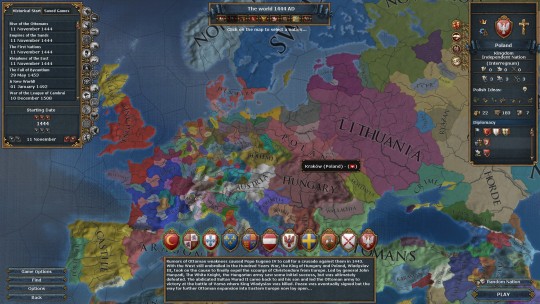
I'm a beginner to this game and I found myself constantly restarting instead of accepting my mistakes, despite playing Ironman to limit savescumming. So I am going to playlog here to try to hold myself to account better.
I had spend a while getting accustomed to things and getting over my own initial "ick" factor when it came to conquering territory, but I decided in the grand scheme of things, Poland is a country I'm happy to try to help become a superpower instead of being partitioned by its neighbours, given they were an incredibly tolerant country (for the era). Plus the Hussars are pretty cool.
To begin with, my goals are going to be
Reincorporate the Crusader Knight Kingdoms to the north into Poland and Lithuania, and maintain the Commonwealth as a tolerant and robust state in Europe.
Slow down Muscovy as much as possible and try to stop Imperial Russia forming, because they'll be a permanent headache.
Return the Balkans to native rule, probably by vassal feeding Bulgaria back it's cores in reconquest, ultimately removing the Ottomans from Europe.
Otherwise, try to grow in the way the game's missions encourage.

The usual start, summon diet, claim land. It's always nice to get the free Papal Points demand as your first Agenda.

Poland's Sejm (Parliament) gives the nobility a huge amount of loyalty and influence by default so I don't need any other privileges for them. Burghers I enforced interfaith dialogue, gave orthodox autonomy and took the prestige boosting patronage of the arts.

I allied Lithuania (you get a Personal Union over them very shortly anyway) and guaranteed Odoyev, a small state near enough to Lithuania that I can vassalise, getting to it before Muscovy can.
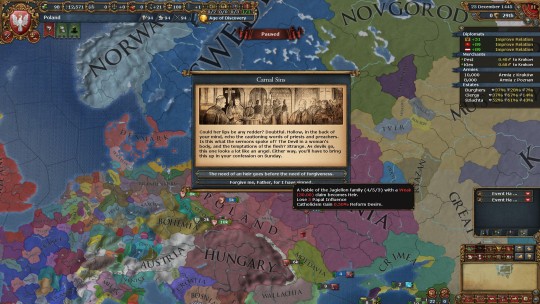
These are pretty good stats so I took the heir.

After a brief period of not having enough rivals (awkward), getting the Personal Union with Lithuania allowed me to set Muscovy as a rival. My rivals are now Hungary, Muscovy and the Ottomans.
I would like to be on good terms with Austria but they usually end up Allying Hungary. I will probably have to fight them later. So be it.

Bohemia started a war with Brandenburg pretty early on. I decided to ally Brandenburg to get dragged in, since most of Bohemia's territory is in the same cultural group as Poland (West Slavic), and it's vassals are in the Krakow Trading Node. But first I had to build to force limit and restore my army's morale.
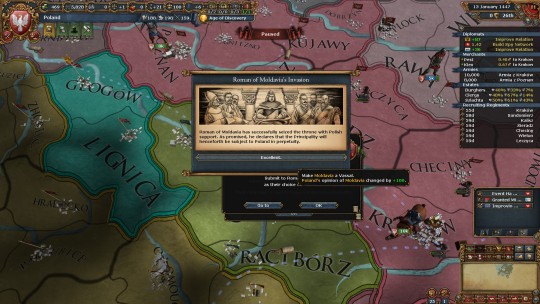
The Moldovan Vassalage event fired off successfully whilst I was building up my army. With two vassals, I could pick the strong duchies estate privilege, increasing my diplomatic relation slots.
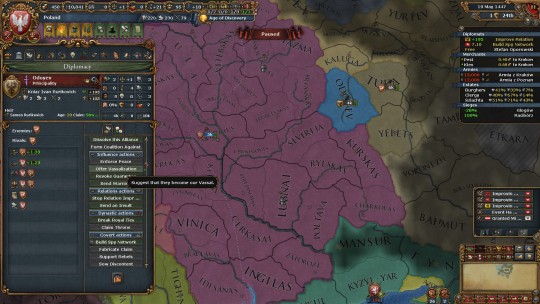
I just barely beat Muscovy to the punch on securing Odoyev as a Vassal. I had to send them a gift to hit the 190 rep in time.

The war went pretty well and I occupied Bohemia's vassals fully, before peacing out seperately. Unfortunately I didn't have any fabricated claims so it was a bit more expensive than I would have liked it to have been. I don't want to be in a war too long with Bohemia because the Danzig event is going to start being able to fire off soon in Prussia.

That about does it for this session.
1 note
·
View note
Text
Blog3 SOURCES AND SIGNIFICANCE SESSION 4 Realism in Porco Rosso
Porco Rosso is an animated film by Studio Ghibli, directed by Hayao Miyazaki, about the magical realistic fairy tale of Porco, who is cursed by himself and turned into a pig to fight against air robbers and protect those around him.
The film is undoubtedly an animation given to us by Representation, without realistic images or simulations. But based on the context in which it was created, the content of the story, and the style of the images, it can be said that it is an animation that represents realism uniquely and powerfully. I will divide it into social realism and animated realism to analyze in depth how the work uses the realism strategy.
Realism;
Social realism, fiction films closely linked to the documentary, attempts to portray, communicate and reveal real conditions of life
War
The film is set in 1920s Italy, with the same European-inspired setting and music, and the production committee traveled to the Adriatic coast for a more realistic representation of the local culture. Most of the story takes place in the Adriatic Sea between Italy and the former Yugoslavia, except for the part where Boruc goes to Milan. Polk lives on an island in the Adriatic Sea along the Croatian coast. At first, Miyazaki intended the story to be set in Dovrok, Croatia. However, just as he was working on Porco Rosso, the civil war in the former Yugoslavia broke out, which came as a great shock to Miyazaki. As a result, the story is a little more serious than he expected, and he moves it out of Croatia and with anti-war ideas.
Porco Rosso is one of the few of Miyazaki's works to have a definite period setting, except Porco turning into a pig due to a curse, which smacks of the supernatural, the main periods and scenes are set in detail according to the real world. There is also an in-depth study of Italy at the time, as can be seen in many of the details (although there are some misspellings in Italian).
Although Porco Rosso is set in the interwar period, which the plot suggests would be the 1930s during the Great Depression, the women's clothing is from the 1920s. There are also several references to Fascism, so although Porco Rosso is set in the 1920s, the characters, settings, and objects are changed for the sake of the plot. This is not realistic enough.
Most of the seaplanes featured in the animation are real-life ones, such as the Savoia S-21 (which differs in some respects), the Curtiss-Wright R3C-0, and the World War I Hansa-Brandenburg CC.
Although it is not explicitly stated why Polluck became a pig, it is implied that Polluck became a pig because he did not want to become a fighter for the Italian Fascist Party and joined the army, preferring to become a pig rather than a Fascist. It is worth noting that Pollux was originally a hero of aerial warfare, but was accused of being a "lazy pig" for opposing fascism, so in the eyes of the people, he became a pig, perhaps as a criticism and satire of fascist society. Another reason is to distance himself from Gina to remain loyal to his dead friend (the protagonist's comrade was Gina's first husband).
Each of the characters in Porco Rosso has its specific reality: the members of the "Manmayut" aerial bandit league in the film are made up of different ethnic groups from the various regions that sparked the war in Europe, including the French, the Swiss, the Sicilians, the late Normans, the Provençals, the Austro-Hungarians, the former nobility, the Croats, etc. The original nobility, the Croats, and so on. Their appearance represents the characteristics of different nationalities, which in the film transcend nationalities and races and are united in an anarchist group of pirates. The main character, "Red Pig", whose real name is Marco Pagot, is often referred to in the film by his nickname, "Red Pig". He is often referred to by his nickname, "Pollux Russell". "Porco Rosso" is the Italian pronunciation of "red pig" (Porco Rosso).
According to Miyazaki, "red pig" was probably originally a term of contempt for socialists and anarchists by the Italian Fascists.
The different attitudes of civilians and the military
Animation as realism, can address real social issues in unique and powerful ways
Representation and Simulation are Representation
How to react to reality funnily with animation
Poverty
In The Red Pig, poverty is depicted in several episodes, whether it is the underclass or the group of airline thieves, or even the main character, the Red Pig, who is constantly in poverty, the direct cause of this situation being the war.
The Repairman
The Red Pig's plane is damaged and sent to the Paul Krogh Company for repair. Although the Red Pig offers a table full of money, the owner of the repair company says that this is not enough and that he will pay the rest in installments.
"Money is worthless these days, it's like scrap paper, it's all gone at once."
This statement is telling us that the war has led to a shortage of materials and that inflation is so severe that money has become worthless.
The downturn in the industry and the hardships of life caused all three of the owner's sons to go out and earn a living.
The night Fio talks to the Red Pig tells us:
'I've heard a lot about Fuck Mark Barkett, he was in the same army as my dad.'
Fio's father went into the army.
Who would want to leave home and work to be a soldier if life wasn't hard?
The women
The temporary maids recruited by Boss Paokolo to build a new plane for the Red Pig were all women who were idle at home - nieces, nephews-in-law, cousins' daughters, the boss's cousin, and even a very old mother-in-law.
"There wasn't even a single man", was the Red Pig's sentiment, and the state of society at the time.
The men had all enlisted to fight in the war, leaving only the women at home.
The film is cryptic, referring to the men as "going out to make money", but according to Fio's father, it is not clear whether they will return.
The thief
If the bosses and the women of Bokoro represent the current situation of the general population, the air thieves represent the grey area. It would be logical to say that making money through dishonorable means, with high risks and high rewards, would make life better, but the truth is that the air thieves are also destitute. They can't afford to repair their airships, buy bombs, or even paint them. This is not an isolated case and is reflected in the fact that groups of air thieves come together to plunder ships.
"Breakage and repair costs are shared deductions, right?"
"And you have to buy your bombs?"
"I'm having engine problems with my dirigible, you guys go first."
When it came to the point of robbery, the air thieves' first concern cost.
The Red Pig's assessment of the air thieves is that they are "poor, cheap, and don't bathe".
This is not an exaggeration, as evidenced by the fact that some of the air thieves took a bath, later on, to have their picture taken with Fio.
The air thieves, although disgraceful, had no choice. It was hard to survive, and the reluctance to join the army made it the best option for these people.
The Red Pig
As the protagonist, Red Pig is an excellent bounty hunter, earning money that even makes the bank staff hot.
But this is only superficial. The plane that Red Pig bought through a loan has broken down and is unable to fly after his latest mission when he has just finished paying off the loan.
By the time the Red Pig had finished repairing the plane, the debt would have to be repaid in installments, entering a dead-end cycle of never being able to pay off the debt and never making any money. If it hadn't been for the large sums of money won by the "Cadiz", I'm afraid the installments would have been a long time coming. It would have taken a long time to repay. This is still the aura of the protagonist, and other bounty hunters, the survival of the situation must be more worrying. Especially after the provisional government cooperated with the Air Thieves' Car Corps, the bounty hunters' economic source was completely cut off.
There are no direct scenes of war, no tragic deaths of families, but in a few words, we get a sense of the brutality of war. There are many funny scenes and even the air thieves are cute in their way. But underneath the funny elements is the stark reality of the war. Underneath all the funny elements, the film has an "anti-war" theme.
Reference
Miyazaki,H.(1992).Porco Rosso[online]. Available from: www.netflix.com/gb/title/70019060&cd=37&hl=zh-CN&ct=clnk&gl=uk
0 notes
Photo

POD: December 1241 - Ögedei Khan manages to avoid drinking himself to death in a bout with Abd-ur-Rahman, and the conquest of Europe continues for another decade.
1251 - Ögedei Khan, having presided over the conquest of the northern territories of the Holy Roman Empire dies at his encampment along the English Channel. The Mongol Empire soon splinters and Batu Khan establishes the Tzarkhanate after calling a kurultai for dominion over Mongol Europe.
1253 - Start of the Polish Revolts led primarily by Casimir of Kuyavia, the heir to the Piast dynasty following the death of Duke Bolesław V. The rebellion lasts over a decade, but constant infighting from rival nobles prevents Casimir from gaining the upper hand over the Prussian and Lithuanian vassals of the Rus.
1265 - The Margraviate of Brandenburg revolts against the Khanate hoping to spark a wider German revolt, however the nobles are never able to consolidate around a leader.
1282 - Constantinople falls to a combined force of Turks who were driven out of eastern Anatolia by the Ilkhanate. The Byzantines are progressively driven back to the Peloponnese and the surrounding territories.
1319 - At Kalmar the Swedes, Norwegians, and remnants of the Danish court agree to form a personal union under Magnus IV of Sweden, largely in response to the death of Eric VI of Denmark during the Mongol conquest of Jutland.
1339 - Pope Nicholas V and Holy Roman Emperor Louis IV meet in Rome to launch the Anti-Mongol Crusade. Concurrently, King Edward III of England launches what would become the War of French Liberation (1339-1422).
1350 - The Anti-Mongol Crusade comes to an end after the humiliating defeat at Vienna. Emperor Louis IV returns to Rome and officially dissolves the Holy Roman Empire in favor of direct rule over Italy as the first of the Wittelsbach Kings. Louis and his heirs continue to claim the Duchy of Bavaria.
By the middle of the 14th Century the Tzarkhanate is seen by the rest of Europe as a badly run state with an arrogant polyglot culture, unworthy to call themselves Europeans. But the fact remains that the Tzarkhanate is also the wealthiest and most powerful realm in European history, and its nobility remain surprisingly unified despite (or possibly because of) a chaotic political system. Mongol overlordship would continue until the end of the 15th century with the "Great Stand on the Volga River" leading to the establishment of a genuine monarchy centered at Moscow under the Rurik dynasty.
Thanks to all my Patreon supporters who made this map possible. All my patrons get early access to my projects before they go live. Please subscribe at: patreon.com/SeanMcKnight
1 note
·
View note
Text
KARL WILHELM FRIEDRICH
Margrave of Brandenburg-Ansbach
THE WILD MARGRAVE
(born 1712 - died 1757)

pictured above is a portrait of the Margrave of Brandenburg-Ansbach, from c. 1750
-------------------- ~ -------------------- ~ --------------------
SERIES - On this day August Edition: Karl Wilhelm Friedrich died on 3 August 1757.
-------------------- ~ -------------------- ~ --------------------
KARL WILHELM FRIEDRICH was born in 1712, in Ansbach, the capital of the Principality of Brandenburg-Ansbach. He was the eldest children of Wilhelm Friedrich, Margrave of Brandenburg-Ansbach and Princess Christiane Charlotte of Württenberg-Winnental.
The Margraviate of Brandenburg-Ansbach was a Free Imperial Principality in the Holy Roman Empire established in the late 14th century. It was ruled by the Brandenburg-Ansbach branch of the HOUSE OF HOHENZOLLERN, of which he was a member.
By 1729 he married his cousin FRIEDRIKE LUISE, a Princess of Prussia, and they had two sons (check the list below). She was one of the daughters of Friedrich Wilhelm I, King of Prussia and Princess Sophie Dorothea of Hanover.
In 1757 he succeeded his father as MARGRAVE OF BRANDENBURG-ANSBACH and ruled the Principality of Ansbach as an absolute Monarch leaving an enormous debt to his son and successor.
Aged 45, he died on 3 August 1757, at his residence in the town of Gunzenhausen (now in Bavaria).
-------------------- ~ -------------------- ~ --------------------
He was the penultimate Hohenzollern to rule as Margrave of Brandenburg-Ansbach as his son and successor Margrave Alexander did not have children, and sold the Margraviate in 1791 to his cousin Friedrich Wilhelm II, King of Prussia.
His son also inherited the Margraviate of Bayreuth in 1769, after another Hohenzollern branch became extinct. This Principality was also included in the 1791 sale and both Margraviates were annexed to the Kingdom of Prussia.
However as the Prussians were members of the main line of the House of Hohenzollern the territories continued in the Family hands.
-------------------- ~ -------------------- ~ --------------------
KARL WILHELM FRIEDRICH and his wife FRIEDRIKE LUISE had two children...
Margrave Karl Friedrich August of Brandenburg-Ansbach - died aged four; and
Alexander, Margrave of Brandenburg-Ansbach - husband first of Princess Friederike Caroline of Saxe-Coburg-Saalfeld and second of Lady Elizabeth Berkeley.
#karl wilhelm friedrich of brandenburg ansbach#margrave of brandenburg ansbach#hohenzollern#house of hohenzollern#german royals#german nobility#royal#royals#monarchy#monarchies#royal history#german history#european history#world history#history#history lover#18th century#frederick william i#frederick william ii#prussian royal family#history with laura
0 notes
Text

• Hanna Reitsch
Hanna Reitsch was a German aviator and test pilot. Along with Melitta von Stauffenberg, she flight tested many of Germany's new aircraft during World War II and received many honors. She set more than 40 flight altitude records and women's endurance records in gliding and unpowered flight, before and after World War II.
Reitsch was born in Hirschberg, Silesia (today Jelenia Góra in Poland) on March 29th, 1912 to an upper-middle-class family. She was daughter of Dr. Wilhelm Willy Reitsch, who was ophthalmology clinic manager, and his wife Emy Helff-Hibler von Alpenheim, who was a member of the Catholic Austrian nobility. Hanna grew up with two siblings, her brother Kurt, a Frigate captain, and her younger sister Heidi. She began flight training in 1932 at the School of Gliding in Grunau. While a medical student in Berlin she enrolled in a German Air Mail amateur flying school for powered aircraft at Staaken, in a Klemm Kl 25. In 1933, Reitsch left medical school at the University of Kiel to become, at the invitation of Wolf Hirth, a full-time glider pilot/instructor at Hornberg in Baden-Württemberg. Reitsch contracted with the Ufa Film Company as a stunt pilot and set an unofficial endurance record for women of eleven hours and twenty minutes. In January 1934, she joined a South America expedition to study thermal conditions, along with Wolf Hirth, Peter Riedel and Heini Dittmar. While in Argentina, she became the first woman to earn the Silver C Badge, the 25th to do so among world glider pilots. In June 1934, Reitsch became a member of the Deutsche Forschungsanstalt für Segelflug (DFS) and became a test pilot in 1935. Reitsch enrolled in the Civil Airways Training School in Stettin, where she flew a twin-engine on a cross country flight and aerobatics in a Focke-Wulf Fw 44. At the DFS she test flew transport and troop-carrying gliders, including the DFS 230 used at the Battle of Fort Eben-Emael.
In September 1937, Reitsch was posted to the Luftwaffe testing centre at Rechlin-Lärz Airfield by Ernst Udet. Her flying skill, desire for publicity, and photogenic qualities made her a star of Nazi propaganda. Physically she was petite in stature, very slender with blonde hair, blue eyes and a "ready smile". She appeared in Nazi propaganda throughout the late 1930s and early 1940s. Reitsch was the first female helicopter pilot and one of the few pilots to fly the Focke-Achgelis Fa 61, the first fully controllable helicopter, for which she received the Military Flying Medal. In 1938, during the three weeks of the International Automobile Exhibition in Berlin, she made daily flights of the Fa 61 helicopter inside the Deutschlandhalle. In September 1938, Reitsch flew the DFS Habicht in the Cleveland National Air Races. Reitsch was a test pilot on the Junkers Ju 87 Stuka dive bomber and Dornier Do 17 light/fast bomber projects, for which she received the Iron Cross, Second Class, from Hitler on March 28th, 1941. Reitsch was asked to fly many of Germany's latest designs, among them the rocket-propelled Messerschmitt Me 163 Komet in 1942. A crash landing on her fifth Me 163 flight badly injured Reitsch; she spent five months in a hospital recovering. Reitsch received the Iron Cross First Class following the accident, one of only three women to do so.
In February 1943 after news of the defeat in the Battle of Stalingrad she accepted an invitation from Generaloberst Robert Ritter von Greim to visit the Eastern Front. She spent three weeks visiting Luftwaffe units, flying a Fieseler Fi 156 Storch. On February 28th, 1944, she presented the idea of Operation Suicide to Hitler at Berchtesgaden, which "would require men who were ready to sacrifice themselves in the conviction that only by this means could their country be saved." Although Hitler "did not consider the war situation sufficiently serious to warrant them...and...this was not the right psychological moment", he gave his approval. The project was assigned to Gen. Günther Korten. There were about seventy volunteers who enrolled in the Suicide Group as pilots for the human glider-bomb. By April 1944, Reitsch and Heinz Kensche finished tests of the Me 328, carried aloft by a Dornier Do 217. By then, she was approached by SS-Obersturmbannführer Otto Skorzeny, a founding member of the SS-Selbstopferkommando Leonidas (Leonidas Squadron). They adapted the V-1 flying bomb into the Fieseler Fi 103R Reichenberg including a two-seater and a single-seater with and without the mechanisms to land. The plan was never implemented operationally, "the decisive moment had been missed."
In her autobiography Fliegen, mein Leben Reitsch recalled that after two initial crashes with the Fi 103R she and Heinz Kensche took over tests of the prototype Fi 103R. She made several successful test flights before training the instructors. "Though an average pilot could fly the V1 without difficulty once it was in the air, to land it called for exceptional skill, in that it had a very high landing speed and, moreover, in training it was the glider model, without engine, that was usually employed." In October 1944, Reitsch claims she was shown a booklet by Peter Riedel which he'd obtained while in the German Embassy in Stockholm, concerning the gas chambers. She further claims that while believing it to be enemy propaganda, she agreed to inform Heinrich Himmler about it. Upon doing so, Himmler is said to have asked whether she believed it, and she replied, "No, of course not. But you must do something to counter it. You can't let them shoulder this onto Germany." "You are right," Himmler replied. During the last days of the war, Hitler dismissed Hermann Göring as head of the Luftwaffe and appointed Reitsch's lover, von Greim, to replace him. Von Greim and Reitsch flew from Gatow Airport into embattled Berlin to meet Hitler in the Führerbunker, arriving on April 26th, as the Red Army troops were already in the central area of Berlin. Reitsch and von Greim had flown from Rechlin–Lärz Airfield to Gatow Airfield in a Focke Wulf 190, escorted by twelve other Fw 190s from Jagdgeschwader 26 under the command of Hauptmann Hans Dortenmann. In Berlin, Reitsch landed a Fi 156 Storch on an improvised airstrip in the Tiergarten near the Brandenburg Gate. Hitler gave Reitsch two capsules of poison for herself and von Greim. She accepted the capsule.
During the evening of April 28th, Reitsch flew von Greim out of Berlin in an Arado Ar 96 from the same improvised airstrip. This was the last plane out of Berlin. Von Greim was ordered to get the Luftwaffe to attack the Soviet forces that had just reached Potsdamer Platz and to make sure Heinrich Himmler was punished for his treachery in making unauthorised contact with the Western Allies so as to surrender. Troops of the Soviet 3rd Shock Army, which was fighting its way through the Tiergarten from the north, tried to shoot the plane down fearing that Hitler was escaping in it, but it took off successfully. Reitsch was soon captured along with von Greim and the two were interviewed together by U.S. military intelligence officers. When asked about being ordered to leave the Führerbunker on April 28th, 1945, Reitsch and von Greim reportedly repeated the same answer: "It was the blackest day when we could not die at our Führer's side." Reitsch also said: "We should all kneel down in reverence and prayer before the altar of the Fatherland." When the interviewers asked what she meant by "Altar of the Fatherland" she answered, "Why, the Führer's bunker in Berlin ..." She was held for eighteen months. Von Greim killed himself on May 24th, 1945. Evacuated from Silesia ahead of the Soviet troops, Reitsch's family took refuge in Salzburg. During the night of May 3rd, 1945, after hearing a rumour that all refugees were to be taken back to their original homes in the Soviet occupation zone, Reitsch's father shot and killed her mother and sister and her sister's three children before killing himself.
After her release Reitsch settled in Frankfurt am Main. After the war, German citizens were barred from flying powered aircraft, but within a few years gliding was allowed, which she took up again. In 1952, Reitsch won a bronze medal in the World Gliding Championships in Spain; she was the first woman to compete. In 1955 she became German champion. She continued to break records, including the women's altitude record (6,848 m (22,467 ft)) in 1957 and her first diamond of the Gold-C badge. During the mid-1950s, Reitsch was interviewed on film and talked about her wartime flight tests of the Fa 61, Me 262 and Me 163. In 1959, Indian Prime Minister Jawaharlal Nehru invited Reitsch, who spoke fluent English, to start a gliding centre, and she flew with him over New Delhi. In 1961, United States President John F. Kennedy invited her to the White House. From 1962 to 1966, she lived in Ghana. The then Ghanaian President, Kwame Nkrumah invited Reitsch to Ghana after reading of her work in India. At Afienya she founded the first black African national gliding school, working closely with the government and the armed forces. The West German government supported her as technical adviser. Reitsch's attitudes to race underwent a change. "Earlier in my life, it would never have occurred to me to treat a black person as a friend or partner ..." She now experienced guilt at her earlier "presumptuousness and arrogance". She became close to Nkrumah. The details of their relationship are now unclear due to the destruction of documents, but some surviving letters are intimate in tone. In Ghana, some Africans were disturbed by the prominence of a person with Reitsch's past, but Shirley Graham Du Bois, a noted African-American writer who had emigrated to Ghana and was friendly towards Reitsch, agreed with Nkrumah that Reitsch was extremely naive politically. Throughout the 1970s, Reitsch broke gliding records in many categories, including the "Women's Out and Return World Record" twice, once in 1976 (715 km (444 mi)) and again, in 1979 (802 km (498 mi)), flying along the Appalachian Ridges in the United States. During this time, she also finished first in the women's section of the first world helicopter championships. Reitsch was interviewed and photographed several times in the 1970s, towards the end of her life, by Jewish-American photo-journalist Ron Laytner.
Reitsch died of a heart attack in Frankfurt at the age of 67, on August 24th, 1979. She had never married. She is buried in the Reitsch family grave in Salzburger Kommunalfriedhof. Former British test pilot and Royal Navy officer Eric Brown said he received a letter from Reitsch in early August 1979 in which she said, "It began in the bunker, there it shall end." Within weeks she was dead. Brown speculated that Reitsch had taken the cyanide capsule Hitler had given her in the bunker, and that she had taken it as part of a suicide pact with Greim. No autopsy was performed, or at least no such report is available.
#ww2#world war 2#second world war#world war ii#wwii#history#german history#biography#aviation#womens history#women in history#germany#airforce history#test pilot
46 notes
·
View notes
Photo

Thursday 03 December 2020 | Berlin, Germany
The French invasion of Belgium took on a new urgency this week after the capture of the city of Namur on the 1st of December. While many European allies offered their support to Belgium, Duchess Elyse Zollern of Prussia took a step back. In the third defection of German nobility, the Duchess announced a press conference in Brandenburg, that she was withdrawing all Prussian troops from Belgium.
“I stand in solidarity with the Belgium people in their struggle against French imperialism.” The Duchess said in a televised press conference at New Palace in Potsdam. “However, Prussian men and women won’t die for Hohenzollern wars. We are are own people and my focus must be on what is best for Prussia. Berlin does not know what we need nor do they have the Prussian people’s best interests at heart.”
At the time of the press conference, 75% of Prussian troops had already pulled out of Belgium and the other 25% are expected to follow by the weekend. We contacted the King’s press team for a comment but did not hear about at the time of initial publication. What we can say is that Duchess Elyse’s comments are the biggest break from the royal family we have seen yet. For the past 4 years, Duchess Elyse has been seen as a loyal supporter of the Hohenzollern’s and has kept a low profile since the 2016 Kaliningrad Affair. It seems times have changed.
10 notes
·
View notes
Text
On this day in history: Battle of Leuthen (1757): Frederick the Great perfects his oblique order.
The Seven Years War (1756-1763) is regarded by many as the first true world war. It was fought on five continents and in many oceans, it was at its heart a battle of supremacy for worldwide influence, namely between Britain and France. Its origins were in colonial conflict between these two powers in North America which became known as the French & Indian War. However, it was also fought with a particularly ferocity in Europe. Britain was not a main participant involved in the European theater, instead this sector of fighting largely centered around their two main allies in this conflict and question of continental supremacy in Central Europe. it was the seeds to the so called German Question, would German speaking lands of Europe, then divided into the many entities of the Holy Roman Empire, be lead by the continual leadership of the Hapsburg Realm known based in the Archduchy of Austria or would it follow the Kingdom of Prussia?
Prelude: The German Question
-By the 18th century, the Holy Roman Empire, Central Europe and the German speaking peoples of Europe had largely been under the leadership of Vienna and the Hapsburg dynasty, then known as the Archduchy of Austria with its rulers serving as Holy Roman Emperor. A title that conveyed certain ceremonial & political weight with it. The Holy Roman Empire was a collection of mostly German speaking states that was concentrated in modern day Germany mostly alongside other parts of Central Europe. The Hapsburgs were its leading family and also held sway directly over parts of Italy, Bohemia, Hungary, Poland, Romania, Croatia, Italy and other parts of the Balkans. In the past its traditional enemy was the Ottoman Empire, long seen as the last bastion between Christendom and the spread of Islam throughout Europe.
-Its success against the Ottomans in the Great Turkish War (1683-1699) alongside Russia, Poland, Venice and other nations has essentially reversed the trend of Ottoman encroachment. Instead, the Turks now found themselves on the defensive and largely having to compete at against an expansionist Russia. Meanwhile, Austria challenged its longtime enemy France, now run by the Bourbon dynasty for control over influence within continental Europe.
-Austria sought Britain and the Dutch Republic’s assistance in containing French supremacy in Western and Central Europe, all these nations had a mutual interest in containing the expansion in French power which was coupled with the Bourbon’s taking over Spain and its empire too.
-Austria and France clashed in the War of the Spanish Succession (1701-1714) and the subsequent War of the Austrian Succession (1740-1748).
-It was in the last 17th and early 18th century and the aforementioned wars, that the Kingdom of Prussia, centered in northeastern Germany and run by the Lutheran Hohenzollern dynasty looked to gain power and influence.
-Prussia was comparatively small relative to Hapsburg lands but it built its reputation on its military prowess, starting with Frederick WIlliam, Elector of Brandenburg. As a member state of the Holy Roman Empire, it had a vote in the election of the Holy Roman Emperor, who was not a direct rule of other members of the fragmentary “empire” but a “first among equals” and one who held the most sway over the collective.
-Frederick William, his son and grandson (Frederick I) & (Frederick William I) were recognized Electors of Brandenburg and in the latter two’s case as Kings in Prussia and they made many military reforms that improved Prussia’s army.
-Under Leopold I, Prince of Anhalt-Dessau who served as Prussia’s royal military overseer a number of key reforms which set it apart from all other European armies were implemented. Firstly, he replaced the traditional wooden ramrod of muskets with which a soldier must plunge the musket ball into the barrel with an iron ramrod. The difference was stark, a more durable iron ramrod had a longer shelf-life than wood, was less prone to breaking and therefore was quicker for reloading. Secondly, he introduced the goose-step march which slowed the march of the army, conserving their energy when going into battle and providing for more uniform cohesion. Thirdly, he increased the role of the fife and drum musicians, making musicians out of some soldier and increasing the size of military marching bands, which was seen to boost morale. Fourth, he introduced relentless drilling with emphasis on the rate of fire and the maneuverability of units in formation. Fifth, the officer corps were directed and limited to the Junker (Prussian nobility) class which had a good miltary education and was firmly loyal to the Prussian nation and King. Additionally, firm but harsh corporal punishment was introduced to instill discipline and deter desertion. Finally, politically the introduction of mandatory conscription was more enforced in Prussia.
-All these elements left in place the Prussian Army becoming perhaps the most well oiled war machine in Europe at the time with only Austria, France, Britain and Russia being competitors, in time they would come to find out just how well trained and efficient this force was.
-As Prussia’s military reputation grew, so did its influence in the world of German politics and Austria clearly began to see it as a rival. Though initially, in the War of the Spanish Succession, both nations were together to curb French influence, with the Prussians serving with distinction as mercenaries under the Holy Roman Empire’s banner.
-1740, however changed things when two new rulers came to rule over Prussia & Austria. It started with Frederick II, the new King of Prussia. Frederick had a troubled relationship with father, Frederick William I. His father was well educated in government and military affairs and had hoped his son and heir would be inclined towards such matters too. Frederick was instead, prone to the burgeoning trends of the Enlightenment then coming into full flourish and sweeping Europe’s philosophy circles. Frederick was more interested in music, the arts and philosophy. His father also physical and mentally abused him, beating him with a cane and calling him many insults. To add to the strain, he appears to have been a homosexual, something punishable by death even for a royal during that time. Famously, he attempted to flee to Britain with his tutor/lover Han Hermann von Katte to escape the abuse by his father. However, both Frederick & Katte were caught in 1730 during their flight. Katte and Frederick were technically army officers and Frederick William I wanted to make an example of them for their flight as a betrayal of the nation. Though Katte’s initial sentence was imprisonment until the King’s death, Frederick William I instead ordered his execution. He made his son watch his friend and lover die by beheading, Frederick is said to have passed out at the sight of his lover’s execution by his father’s order. Frederick himself was also imprisoned by his father for the next two years.
-Eventually, father and son somewhat reconciled. In part, because he got Frederick to marry a woman, Elizabeth Christine of Brunswick-Wolfsbuttel. However, Frederick remained a semi-closeted gay man and never had children with his wife nor had any physical intimacy with her, though appears to have had no affairs with other women either. Instead, he always maintain an interest in the military and quite probably had male lovers & confidantes. Instead, the couple maintained separate residences over the course of their lives and Frederick knew full well the marriage was for political purposes. It was to last from 1733 until his death in 1786.
-Frederick came to the throne in 1740, having inherited a Prussia with a stable economy, efficient administration & most important of all, well trained and sizable army relative to its population. All things despite their often strained relationship he owed to his father. Of his father after his death he said:
“What a terrible man he was. But he was just, intelligent, and skilled in the management of affairs... it was through his efforts, through his tireless labor, that I have been able to accomplish everything that I have done since.”
-1740, also saw accession to the Austrian throne, Maria-Theresa, daughter of Charles VI, Holy Roman Emperor and Archduke of Austria. She had married, Francis, Duke of Lorraine, a Franco-German, portion of the Holy Roman Empire. Together, they would co-rule the Hapsburg Empire & give rise to the Hapsburg-Lorraine branch of the family, as Maria-Theresa was the last in the senior line of the Hapsburg family, which is declared to “die out” due to no more direct male heirs. Their subsequent branch would head the family and rule Austria in its many iterations through World War I in the form of the Austro-Hungarian Empire.
-The issue of Maria-Theresa’s gender came to be the powder keg for growing Austro-Prussian conflict. However, it was a smokescreen to expand Prussian power at Austrian expense, being just a convenient excuse other rulers needed to undermine Hapsburg rule as Holy Roman Emperors. Charles VI, aware of the problems caused by having no male heirs and relying on a system of primogeniture, where the eldest surviving legitimate male son or nearest male relative was given to rule, was forced to spend much of his reign using diplomacy and concessions to the other Electors of the Holy Roman Empire and great powers of Europe, to recognize his daughter as his heir and as Holy Roman Empress and ruler of Hapsburg lands. The Pragmatic Sanction of 1713 was the recognition by the other powers of Europe of her succession to these lands.
-However, looking to weaken the Austrians and get the balance of power set about in a more favorable fashion, France & Prussia backing the relative of Maria-Theresa, Charles-Albert of Bavaria, proclaimed his right to become Holy Roman Emperor. Making him in effect Charles VII, Holy Roman Emperor. He was of the House of Wittelsbach and his reign interrupted the Hapsburg claim to the title for the preceding 300 years. Citing, Salic Law, from the Middle Ages, neither France nor Prussia could truly “respect” a woman’s claim to hold the title of Holy Roman Emperor or to rule over the Hapsburg lands. For France it was about controlling the balance of power, for Frederick of Prussia, now Frederick II, it was a chance to increase Prussia’s profile. So launched the 8 year long War of the Austrian Succession. The war saw Frederick II invade Austrian Silesia in modern day Poland. With this Maria-Theresa & Frederick II were ever after archrivals.
- By 1745, Frederick’s army time and again surprised the Austrians and Europe at large and had more or less secured its war aims, Silesia. He secured for himself a reputation as a great tactician and for the Prussian army, a sense of true respect for their performance. The treaty of Aix-la-Chappelle in 1748 ended the war, Maria-Theresa was declared to be Holy Roman Empress and ruler of all Hapsburg lands with her husband who became Francis I as Holy Roman Emperor. Their family would continue to succeed them ever after. However, Frederick got to retain control of Silesia and this caused simmering tension and resentment with Maria-Theresa.
Diplomatic Revolution:
-In the years following the Treaty of Aix-la-Chappelle, the political goals of Europe’s great powers realigned. Britain and France still retained colonial rivalries the world over and both sought to have a favorable balance of power on the continent as well. Austria & Britain had been traditional allies for decades but with British support for Prussian claims to Silesia, Maria-Theresa no longer felt Britain could be a dependable ally in what she sought, a reclaiming of Silesia, she needed help to achieve this and turned to an unlikely place, its former rival...France.
-Meanwhile, Britain felt Austria itself was too weak to take on France and therefore was willing to subsidize other powers to contain French ambition on the continent while the Royal Navy & British Army took French colonies elsewhere. So a partner switch developed. Prussia & Britain signed an alliance in January 1756.
-Meanwhile. France at first declared neutrality thanks to diplomacy from Austria which no longer had borders on France’s natural borders and this lead to a thawing of icy relations. A series of treaties was signed between Austria and France in 1756-57 which formed an anti-Prussian coalition between the two and later supplemented by Russia & Sweden. France agreed to support Austria regaining Silesia, and subsidies for Austria to maintain a large army against the Prussians. In exchange at the war’s end, France would gain the Austrian Netherlands (Belgium). This would allow France new ports to threaten Britain.
War:
-War had broken out 1756 officially between Britain and France though their North American colonies had been fighting since 1754.
-Frederick II, sensing the growing alliance against him wanted to preempt any Austrian attack against Silesia and thusly invaded the Austrian ally, the Electorate of Saxony in August 1756, this kicked off the war and lead to many back and forth battles over the next 7 years.
-The war shifted in 1757 to Austrian Bohemia (Czech Republic) and left Prague under siege by the Prussians at one point. Frederick garnered many important early victories but was forced to withdraw in this instance.
-By late 1757, the French were providing Austria the long awaited support for its thrusts into Silesia. Prussia was gradually pushed back following the retreat from Prague and now was facing pressure from multiple approaches.
-This approach culminated in the November 1757 Battle of Rossbach, the only physical battle to involve both France & Prussia against each other. Frederick caught the Austro-Franco army by surprise and inflicted 10,000 casualties to his less than 1,000. France essentially remained a non-entity in this theater for the next several years, though they did continue to fund the Austrians. Austria’s real support would come later from Russia & Sweden against Prussia.
Battle of Leuthen:
-Meanwhile, another and even larger Austrian army was looking to engage Frederick, this one was lead by Maria-Theresa’s brother in law, Prince Charles Alexander of Lorraine. He sought to engage the Prussians and defeat Frederick decisively. Indeed he did defeat the Prussians, not under Frederick’s command at the Battle of Breslau in late November 1757 which threatened all of Prussian Silesia in December with 66,000 soldiers under his command.
-Frederick meanwhile had 33,000 meaning his troops would be outnumbered 2 to 1. Learning of the fall of Breslau, he moved his troops, 170 miles in just 12 days, a very accomplished maneuver given the roads and transport of the times.
-Prince Charles, aware of Frederick’s approach’s toward Breslau, the provincial capital of Silesia. He sought to stop the advance 17 miles west at the town of Leuthen.
-The Austrians hoped to check any Prussian countermove with a force running north to south spread out around Leuthen, knowing the Prussians would come from the west.
-Charles had placed his command in the village church tower to give him more of a vantage point over the rolling countryside displayed before his army. This meant he should be able to anticipate any move Prussia made.
-Frederick however, was quite familiar with the land, having used the Silesians countryside around Leuthen as parade and drilling grounds for the Prussian Army during peace time. Rarely one, to do the expected Frederick wanted to use his tactical prowess against the Austrians.
-His first step was to survey the land and hatch a plan. Austria’s strongest concentration of troops was on the left wing (south end) and their front stretched five miles north to south. Frederick, decided he would make the Austrians think he was in one place and then show in an unexpected place. His goal was to get the Austrians to react to this deceit which would provide an opening to his advantage.
-Realizing a series of low lying hills running almost parallel to the Austrian line lie in front of both armies. Frederick planned to use these hills to cover his troops movements for the main strike. First however, a force of cavalry would would launch an attack to distract the Austrians on the north end of the battlefield, the more lightly concentrated side. The Austrians thinking the attack was now coming from the north instead of the south would transfer the greatest concentration of troops from the south to north and check the Prussian attack. Meanwhile, Frederick employing his favorite tactic, oblique order would march from behind the hills to the now weakened south end of the Austrian line, perform a right angle turn and blast volleys into the weakened line, and roll it up from the south end, essentially performing a bait and switch on the Austrians.
-On the morning of December 5th, 1757, fog came onto the field, making it hard to see either side, this helped the Prussians more than the Austrians.
-Prince Charles saw Frederick’s initial moves early in the morning but interpreted them possibly as a retreat at first Meanwhile, Prussian cavalry attacked the north end of the Austrian line from the woods, indeed it seemed as if the Prussians were attacking the north end, having expected a southern end attack initially hence the greater concentration of troops. The worry was this attack coming from an unexpected direction could contribute to the Prussians rolling up the Austrian line.
-Charles reacted by shifting his entire southern flank’s reserve to reinforce and extend the line to the north. His transfer of troops drew out the line’s length and weakened the southern flank. They would in fact be facing the weaker Prussian attack, while the stronger attack would hit their originally anticipated southern flank, now weakened by deception. Little did he realize, he had fallen in Frederick’s trap.
-Indeed, Frederick marched his troops quietly in the fog and behind the hills before the Austrians, before he performed a right turn and executed oblique order, essentially moving the bulk of one’s forces against the weakened flank of the enemy and pushing them back so as to create an opening that forces the enemy line to shift, contort and break. His troops were well timed and disciplined to pull off such a maneuver.
-The main Prussian force marching south behind the hills was in two parallel columns. They moved past the length of the Austrian line and out of sight totally before veering eastward until they formed virtually a right angle with the Austrian line who was surprised by the sight of the Prussian army emerging from fog in battle line formation. The Prussian infantry opened fire with devastating volleys, keep in mind, the rate of five for Prussian infantrymen was 5 shots a minute per man compared to the 3-4 averaged by other European armies of the time. Their hard training had paid off with a faster and consequently more damaging rate of fire than their enemy.
-The Prussians now pushed forward against the confused and bedazzled Austrian army, which ironically, seeking to avoid being rolled up in the opposite direction, weakened their originally stronger side only to be rolled up anyway from a now completely unexpected direction.
-The Austrians had a few regiments try to check the Prussian advance from the south and indeed some artillery pointed south held them at bay but Frederick ordered some artillery of his own to be placed on one of the hills to the west of Leuthen, which in turn enfiladed the Austrian guns and forced them to withdraw.
-Meanwhile the Austrians tried to shift everything south in order to maintain control of the situation but the Prussian cavalry which had launched the screening attack on the Austrin north flank intially had withdrawn until was called into action by Frederick once more, causing more confusion for the Austrians who ultimately withdrew from the field, heading northeast.
-Frederick wanted to pursue but snowfall made him call off the pursuit. That night, Frederick arrived at the castle at nearby Lissa, occupied by both Austrian officers and refugees from villages caught near the battle. He politely surprised the Austrians by acknowledging they did not expect his presence their that night but did ask for lodging. Subsequently he went on to besiege Breslau and force an Austrian surrender.
-The war was far from over and Frederick and indeed Prussia’s fortunes fluctuated until its conclusion in 1763, in which Prussia would technically be the winner, retaining Silesia, in exchange for the recognition of Maria-Theresa’s son, Joseph as her heir. Though the war exhausted both sides in terms of manpower but ultimately, Frederick stopped Austrian +other Germans, French, Russian & Swedish armies from ending Prussia and his reign altogether.
-As a result of his tactical & strategic performance in this war and the preceding War of the Austrian Succession, he earned the historical moniker, Frederick the Great. The Battle of Leuthen was one illustration of the man’s tactical prowess, perhaps the most perfect example of this and more broadly of how far Prussia’s army had come from a comparative German backwater to the premier army on the European continent.
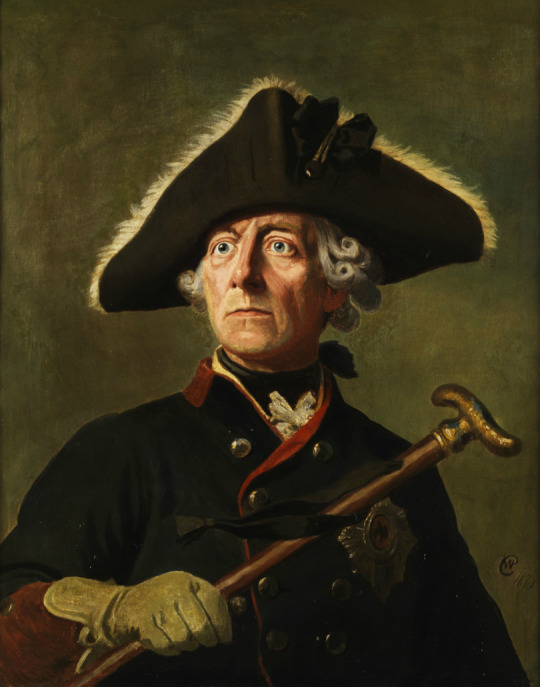

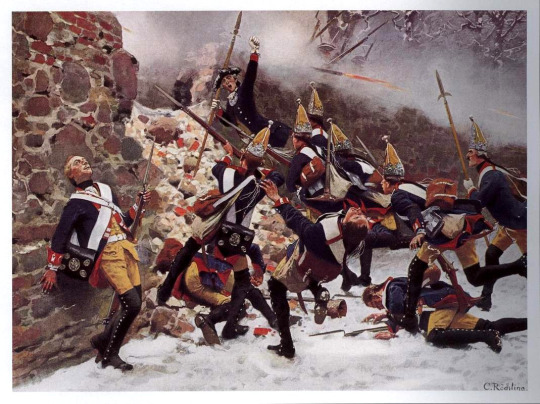

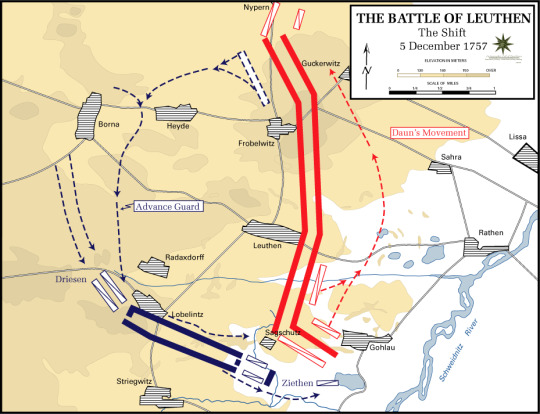


#on this day#military history#Seven Years War#third silesian war#prussia#tactics#oblique order#austria#Frederick the Great#maria theresa#holy roman empire#18th century#military tactics
10 notes
·
View notes
Photo










House of Hohenzollern: Princess Wilhelmine of Prussia
Friederike Sophie Wilhelmine, simply referred to as Wilhelmine, was the third child and first daughter of “The Soldier King” Frederick William I. in Prussia and his wife Princess Sophia Dorothea of Hanover, the daughter of the later King George I. of Great Britain and Ireland. She was their first child to survive into childhood and is older and favourite sister of Frederick the Great.
During her childhood, she was abused by her governess Leti. She beat her almost everyday. It got even worse when Wilhelmine started to respond only vaguely to questions about her mother’s and maternal grandfather’s marriage plans for her. Leti had been bribed by Friedrich Wilhelm von Grumbkow and Leopold I, Prince of Anhalt-Dessau, to convince Friederike of a marriage to The Prince’s nephew Frederick William, Margrave of Brandenburg-Schwedt. Only when Madame de Roucoulles, the governess of the Prussian princes, explained to Wilhelmine’s oblivious mother in 1721 that she would probably one day become disabled from all those beating, Leti was let go and Dorothea Luise “Sonsine” von Wittenhorst-Sonsfeld was employed in her stead.
Wilhelimne knew of the escape plans of her brother Frederick which failed in the August of 1730. Like her brother, she had been friends with Hans Hermann von Katte. He two had known about the escape plans and would ultimately become the scape goat for Frederick William’s fury. While Frederick and Hans were imprisoned at Küstrin, Wilhelmine was locked in her room. For over a year, she and her brother had to fear to be executed. In the end their father decided to only execute Hans but made Frederick watch the execution. Wilhelmine on the other hand was to be married off. Her governess was told to make the princess obedient to her father’s orders. If she did not succeed, she would be put into a correction facility with the public whores.
Some contemporaries say that Wilhelmine’s husband was initally intended for her younger sister Princess Sophia Dorothea of Prussia, who would later become The Margravine of Brandenburg-Schwedt, but other’s say that Frederick, The Margrave of Brandenburg-Bayreuth, had always been intended to be Wilhelmine’s spouse. They were married on November 20th, 1731, in Berlin. When Wilhelmine left Berlin for Bayreuth on January 11th, 1732, she was already two month pregnant. Her only child Elisabeth Friederike Sophie was born on August 30th that year and would later be called “the most beautiful princess in Europe” by no one less than Casanova himself.
But Wilhelmine did not like her new home particularly much. It was simpler then the Prussian court she was used to and her thought the castle to be dark and in bad condition. However, to her parents and her brother she wrote positively about her welcome in Bayreuth, unlike in her memoires.
In her time as Margravine, she built many things in Bayreuth that still atract many tourists today. Next to building, Wilhelmine was a passionate champion of the arts and practised most of them herself. She loved to paint and act and was also a talented musician from early age on. Wilhelmine even composed her own pieces including an entire opera. But she was also interested in science and philosophy and corresponded with Voltaire.
There was also a time when her relationship with her young Brother Frederick the Great soured for a time. It all began when Wilhelmine decided to get rid of Wilhelmine Dorothee von der Marwitz, her lady-in-waiting turned mistress of her husband, and arranged a marriage for her with the Austrian Count Otto von Burghauß. Austria and Prussia were enemies at the time and Wilhelmine Dorothee’s inheritance from her Prussian father would by this marriage go to Austria. Frederick was not amused about this since the Prussian nobility was forbidden to marry outside of Prussia without the King’s approval. As a consequence, Frederick disinherited Dorothee from her father’s inheritance. Another issue that soured their relationship was that Austrian diplomats tried to influence the Prussian court via Bayreuth and Wilhelmine’s open admiration of Maria Theresia who was the ruling Archduchess of Austria as well as Queen regnant of Bohemia and Hungary at the time. The two women even met during the Slesian war in 1745. Wilhelmine and Frederick met one another in person the last time in June 1745.
Wilhelmine died on October 14th, 1758, in Bayreuth; the same day her brother lost Battle of Hochkirch in the Seven Years War and also lost his friend James Keith in the same battle. Ten years after her death, Frederick built the Temple of Friendship in Sanssouci Park to remember his sister. From 2008 to 2016, the city of Bayreuth gave out the Markgräfin-Wilhelmine-Preis der Stadt Bayreuth für Toleranz und Humanität in kultureller Vielfalt [Margravine-Wilhelime-Price of the city of Bayreuth for tolerance and humanity in cultural diversity] in her honor. Wilhelmine’s life is well documented thanks to her self-written memoire, although it should also be taken with a grain of salt since it was written later in life and only reflect her personal opinion at the time of writing and not neccessarily the truth, as it is with every memoire. The autobiography has been published in at least French, German and English.
// Anna Willecke as Wilhelmine von Preussen in Friedrich - Ein deutscher König (2011)
#historic women#women in history#period drama#perioddramaedit#German history#Wilhelmine of Prussia#Frederick the Great#Friedrich der Große#House of Hohenzollern#Royal Women of Prussia#sisters of Frederick the Great
224 notes
·
View notes
Text
Week 1 (Jan 6 - 13)
Hallo aus Berlin!!
I’m so excited to share with you what I've been up to the past week! It’s been pretty crazy getting adjusted to my new dorm, learning how to get around in Berlin, going to the store, and meeting new people. I can already tell I’m going to love Berlin and I’ve had such a great time so far. This post is so much longer than I anticipated, but I hope you enjoy reading about my first week!!
Last Sunday, I took one plane from Charlotte to London and then a short flight from London to Berlin. Everything went smoothly with with the flights and I got a few hours of sleep which was good! The meal I got on the plane was a pasta dish, which was pretty delicious. Here’s a picture of the airline meal and a picture of me with my suitcase for proof that I packed light!


I met up with some people in my same program who were on my flight from London to Berlin. Once I got to the Berlin airport, I met up with my roommate, who is also named Sarah, and then the program provided a bus that took us from the airport to the program center.
The place where I’m staying is a center for study abroad students from the US. The bottom section has a lobby and cafe and classrooms and then the top floors are the rooms where students live. My room is dorm style with bunk beds, a desk, a wardrobe, a mini-fridge/microwave set, and then a bathroom. Here are a few pictures!



The first day we were in Berlin we had a welcome toast to the semester, then we went on a short walking tour around the neighborhood, and then dinner with some people in the program.
One the second day, we had morning sessions that covered helpful information about our classes, the center, and the culture in Berlin. Then in the afternoon, we went on one of those bus tours of Berlin, which was cool because we saw the main tourist attractions (pictures below!) and learned about their history in addition to getting a better feel for the layout of the city. And by that I mean realizing just how big Berlin is!
The first stop was the East Side Gallery, which is the longest remaining piece of the Berlin Wall. After it was torn down, the city preserved this section and asked local artists to paint what peace and unity meant to them, so it’s covered in really cool murals. This picture is probably the most famous section - it depicts Leonid Brezhnez (Leader of the Soviet Union) and Erich Honecker (East Germany Leader) kissing and was based off of a photo taken when the German Democratic Republic (East Germany) was created.

Then we went to the Brandenburg Gate, which was pretty cool just because you see references to it everywhere in the city (including on the fabric in the seats in the U-Bahn) But the history of it is super cool - it’s actually pretty old (18th century) and was a part of the old Berlin Customs Wall, which was a literal wall around the city that regulated people to pay taxes on the goods they brought into and out of the city. The Brandenburg Gate was one of many gates in the wall, but it was used for people of higher nobility or special occasions. Then it was used later for triumphal processions by Napoleon and the Nazis.
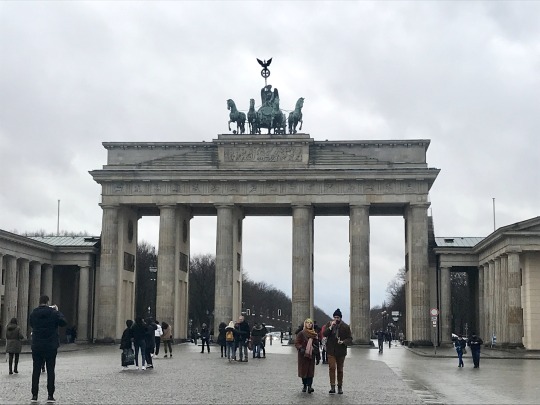
The last stop was the Memorial to the Murdered Jews of Europe. It’s hard to get a good picture that shows the whole memorial because it’s so big, but it’s a large open space with grey concrete-looking boxes of various heights. There’s apparently a lot of controversy about this memorial, but the artist, Peter Eisenman, was also very intentional in his design. The monument resembles a cemetery and walking through the stone boxes makes you feel somewhat uncomfortable and trapped. Eisenman didn’t want to label the monument or label the boxes because he wanted viewers come to their own realization and form their own opinions about the meaning behind his work. The monument is one of the largest public spaces in Germany and was really moving. There’s also an underground documentation section, but we didn’t see that on our tour.

That night we went to a German/Austrian restaurant, and I had my first schnitzel of the semester! This was a veal schnitzel that is popular in Austria and it was incredible. I’ve also been trying different beers at restaurants because Berliners are obsessed with their beers.

P.S. the beer glass was smaller so don’t use it as a size comparison to the schnitzel which looks ginormous in this picture
On Wednesday we started our first day of class! I only had my International Finance class that day, but I think the class will be really interesting. The professor is also really awesome - he was discussing a concept in class and mentioned this tea beverage but no one in the class knew what he was talking about because it’s only made in Berlin, so during our break (they’re 10 minutes since the class the 3 hours) he went a bought one and had some plastic cups so we could all try it!
We also went to Real, which is kind of like Germany’s Walmart or Target. It was my first experience going on the U-Bahn (Berlin’s subway/metro) and to the store in Berlin and it was a wild experience. The U-Bahn is pretty simple, especially given my experience in New York, but it’s big and all the names of the stops have at least ten letters. At the store, they have a lot of the same brands as the United States, but it was definitely an experience. I just got some notebooks for class and other things that I didn’t want to worry about packing like a bigger shampoo bottle. The whole trip was a little overwhelming but my friends from the program were there too so we struggled together and are now laughing about how confused we were.
On Thursday, we went to the grocery store for the first time! It was super fun and we got stuff to make dinner and lunch since there is a communal kitchen at the center. I have a picture just because I was proud that we went and were cooking. Also, in the German grocery stores they only sell half loaves of bread and I think that’s genius. Also their cheese is way better than deli cheese from Harris Teeter.

It was also a slightly warmer and sunnier day, so we went for a walk around the neighborhood. The river was super beautiful and we also saw some interesting apartments too.


Afterwards, we went to a super cute cafe where we had some coffee and cherry cake.

On Friday, I don’t have any classes which means I got to spend a full day doing whatever I wanted! We went to this mall and got some more items that we needed and also just walked around to the different stores to see what they were like.
That afternoon we also went to the Berliner Dom, which is the big Cathedral in Berlin. It was super beautiful on the outside and it sits on what they call “Museum Island” because it’s an island in the middle of the Spree River that runs through Berlin and is where a lot of the main museums are. The inside is also really pretty and you can go to the top and see an awesome view of Berlin! It was foggy and dark outside when we were there but I’d like to go back when you can see more.



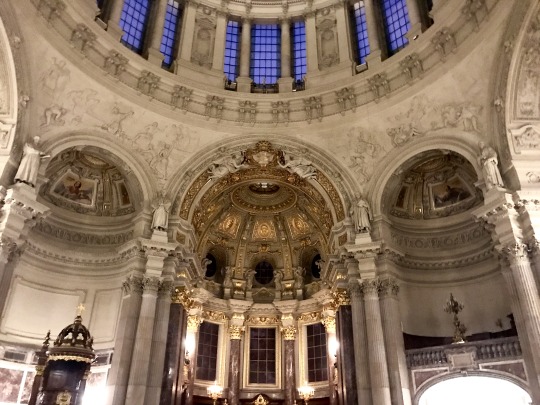

This is the view from the top! The TV Tower is to the left.
Also, a little bit of winter-y decorations were still up from Christmas and I thought they were really pretty!!


That night, we went to Curry 36, which they say at the program is a late-night staple. It’s a currywurst place, which is a fast-food dish consisting of sausage, French fries, curry-flavored ketchup, and mayonnaise. It is honestly life-changing and I would consider Curry36 similar to the Cookout of Berlin, which as many of you know is a pretty bold statement coming from me.

On Saturday, I went to an all-day German Survival Course that the program put on. It was somewhat helpful because we learned a little about ordering food and how to say some phrases. It’s definitely a hard language though so I can’t say that I have a large German vocabulary as of now.
Today (Sunday), we went to a brunch place and then a museum called Urban Nation, which is a contemporary art museum that focuses a lot on street art too. It was super cool.




And then tonight I’m just finishing up some homework!
Wow - it’s been a really busy week but I’ve loved being able to explore and experience new things, even if it was sometimes intimidating. Berlin seems like an amazing city and I’ve loved making new friends who are studying here with me too.
I miss you all!! Auf Wiedersehen!

the view from my dorm!
2 notes
·
View notes
Text
Events 6.11
173 – Marcomannic Wars: The Roman army in Moravia is encircled by the Quadi, who have broken the peace treaty (171). In a violent thunderstorm emperor Marcus Aurelius defeats and subdues them in the so-called "miracle of the rain".
631 – Emperor Taizong of Tang sends envoys to the Xueyantuo bearing gold and silk in order to seek the release of Chinese prisoners captured during the transition from Sui to Tang.
786 – A Hasanid Alid uprising in Mecca is crushed by the Abbasids at the Battle of Fakhkh.
980 – Vladimir the Great consolidates the Kievan realm from Ukraine to the Baltic Sea. He is proclaimed ruler (knyaz) of all Kievan Rus'.
1011 – Lombard Revolt: Greek citizens of Bari rise up against the Lombard rebels led by Melus and deliver the city to Basil Mesardonites, Byzantine governor (catepan) of the Catepanate of Italy.
1118 – Roger of Salerno, Prince of Antioch, captures Azaz from the Seljuk Turks.
1157 – Albert I of Brandenburg, also called The Bear (Ger: Albrecht der Bär), becomes the founder of the Margraviate of Brandenburg, Germany and the first margrave.
1345 – The megas doux Alexios Apokaukos, chief minister of the Byzantine Empire, is lynched by political prisoners.
1429 – Hundred Years' War: Start of the Battle of Jargeau.
1488 – Battle of Sauchieburn: Fought between rebel Lords and James III of Scotland, resulting in the death of the king.
1509 – Henry VIII of England marries Catherine of Aragon.
1559 – Don Tristan de Luna y Arellano sails for Florida with party of 1,500, intending to settle on gulf coast (Vera Cruz, Mexico).
1594 – Philip II recognizes the rights and privileges of the local nobles and chieftains in the Philippines, which paved way to the stabilization of the rule of the Principalía (an elite ruling class of native nobility in Spanish Philippines).
1748 – Denmark adopts the characteristic Nordic Cross flag later taken up by all other Scandinavian countries.
1770 – British explorer Captain James Cook runs aground on the Great Barrier Reef.
1775 – The American Revolutionary War's first naval engagement, the Battle of Machias, results in the capture of a small British naval vessel.
1776 – The Continental Congress appoints Thomas Jefferson, John Adams, Benjamin Franklin, Roger Sherman, and Robert R. Livingston to the Committee of Five to draft a declaration of independence.
1788 – Russian explorer Gerasim Izmailov reaches Alaska.
1805 – A fire consumes large portions of Detroit in the Michigan Territory.
1825 – The first cornerstone is laid for Fort Hamilton in New York City.
1837 – The Broad Street Riot occurs in Boston, fueled by ethnic tensions between Yankees and Irish.
1865 – The Naval Battle of the Riachuelo is fought on the rivulet Riachuelo (Argentina), between the Paraguayan Navy on one side and the Brazilian Navy on the other. The Brazilian victory was crucial for the later success of the Triple Alliance (Brazil, Uruguay, and Argentina) in the Paraguayan War.
1892 – The Limelight Department, one of the world's first film studios, is officially established in Melbourne, Australia.
1895 – Paris–Bordeaux–Paris, sometimes called the first automobile race in history or the "first motor race", takes place.
1898 – The Hundred Days' Reform, a planned movement to reform social, political, and educational institutions in China, is started by the Guangxu Emperor, but is suspended by Empress Dowager Cixi after 104 days. (The failed reform led to the abolition of the Imperial examination in 1905.)
1901 – The boundaries of the Colony of New Zealand are extended by the UK to include the Cook Islands.
1903 – A group of Serbian officers storms the royal palace and assassinates King Alexander I of Serbia and his wife, Queen Draga.
1917 – King Alexander assumes the throne of Greece after his father, Constantine I, is deemed to have abdicated under pressure from allied armies occupying Athens.
1919 – Sir Barton wins the Belmont Stakes, becoming the first horse to win the U.S. Triple Crown.
1920 – During the U.S. Republican National Convention in Chicago, U.S. Republican Party leaders gathered in a room at the Blackstone Hotel to come to a consensus on their candidate for the U.S. presidential election, leading the Associated Press to coin the political phrase "smoke-filled room".
1935 – Inventor Edwin Armstrong gives the first public demonstration of FM broadcasting in the United States at Alpine, New Jersey.
1936 – The London International Surrealist Exhibition opens.
1937 – Great Purge: The Soviet Union under Joseph Stalin executes eight army leaders.
1938 – Second Sino-Japanese War: The Battle of Wuhan starts.
1940 – World War II: The Siege of Malta begins with a series of Italian air raids.
1942 – World War II: The United States agrees to send Lend-Lease aid to the Soviet Union.
1942 – Free French Forces retreat from Bir Hakeim after having successfully delayed the Axis advance.
1944 – USS Missouri, the last battleship built by the United States Navy and future site of the signing of the Japanese Instrument of Surrender, is commissioned.
1955 – Eighty-three spectators are killed and at least 100 are injured after an Austin-Healey and a Mercedes-Benz collide at the 24 Hours of Le Mans, the deadliest ever accident in motorsports.
1956 – Start of Gal Oya riots, the first reported ethnic riots that target minority Sri Lankan Tamils in the Eastern Province. The total number of deaths is reportedly 150.
1962 – Frank Morris, John Anglin and Clarence Anglin allegedly become the only prisoners to escape from the prison on Alcatraz Island.
1963 – American Civil Rights Movement: Governor of Alabama George Wallace defiantly stands at the door of Foster Auditorium at the University of Alabama in an attempt to block two black students, Vivian Malone and James Hood, from attending that school. Later in the day, accompanied by federalized National Guard troops, they are able to register.
1963 – Buddhist monk Thích Quảng Đức burns himself with gasoline in a busy Saigon intersection to protest the lack of religious freedom in South Vietnam.
1963 – John F. Kennedy addresses Americans from the Oval Office proposing the Civil Rights Act of 1964, which would revolutionize American society by guaranteeing equal access to public facilities, ending segregation in education, and guaranteeing federal protection for voting rights.
1964 – World War II veteran Walter Seifert attacks an elementary school in Cologne, Germany, killing at least eight children and two teachers and seriously injuring several more with a home-made flamethrower and a lance.
1968 – Lloyd J. Old identified the first cell surface antigens that could differentiate among different cell types.
1970 – After being appointed on May 15, Anna Mae Hays and Elizabeth P. Hoisington officially receive their ranks as U.S. Army Generals, becoming the first women to do so.
1971 – The U.S. Government forcibly removes the last holdouts to the Native American Occupation of Alcatraz, ending 19 months of control.
1978 – Altaf Hussain founds the student political movement All Pakistan Muhajir Students Organisation (APMSO) in Karachi University.
1981 – A magnitude 6.9 earthquake at Golbaf, Iran, kills at least 2,000.
1987 – Diane Abbott, Paul Boateng and Bernie Grant are elected as the first black MPs in Great Britain.
1998 – Compaq Computer pays US$9 billion for Digital Equipment Corporation in the largest high-tech acquisition.
2001 – Timothy McVeigh is executed for his role in the Oklahoma City bombing.
2002 – Antonio Meucci is acknowledged as the first inventor of the telephone by the United States Congress.
2004 – Cassini–Huygens makes its closest flyby of the Saturn moon Phoebe.
2007 – Mudslides in Chittagong, Bangladesh, kill 130 people.
2008 – Canadian Prime Minister Stephen Harper makes a historic official apology to Canada's First Nations in regard to abuses at a Canadian Indian residential school.
2008 – The Fermi Gamma-ray Space Telescope is launched into orbit.
2010 – The first African FIFA World Cup kicks off in South Africa.
2012 – More than 80 people die in a landslide triggered by two earthquakes in Afghanistan; an entire village is buried.
2013 – Greece's public broadcaster ERT is shut down by then-prime minister Antonis Samaras. It would open exactly two years later by then-prime minister Alexis Tsipras.
0 notes